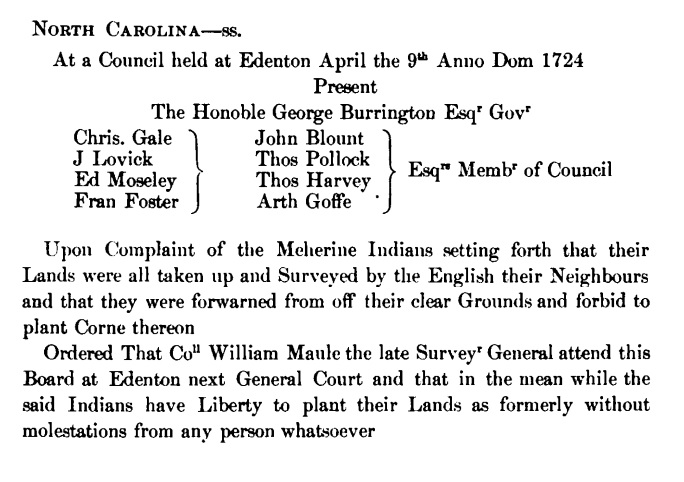1710/1711
…than prudence. The power to execute them was not equal to the zeal which enacted them. Carey had still many adherents, and had no idea of submitting to arrest. His only resource, therefore, was to raise the standard of undisguised rebellion. This he did; and further, again declared himself president amidst the acclama-tions of a misguided multitude. And it so happened that in De-cember, 1710, just before these transactions, the Meherrin Indians, provoked by the ill-treatment of some profligate whites who lived near them, had taken redress into their own hands, and falling on the most distant settlement on the Chowan, had there killed some of the whites. The danger of an Indian war, therefore, should have taught the Assembly the gross imprudence of furnishing a pretext for contemporaneous civil strife.
We have no doubt from subsequent facts, which will be related in their order, that Carey saw the advantages he might derive from Indian hostilities, and resolved to avail himself of them when necessary. He had further satisfaction, also, of seeing the As-sembly so much engrossed by their legislation to punish him, that they actually adjourned without making the least provision to resist a probable Indian attack.
But, in truth, Carey has many adherents, and it may serve to illustrate the embittered hostility which he and his chief company-ions succeeded in creating, when we state that the Quakers even went far beyond their usual circumspection, and practically re-pudiated their own pacific principles. Spotswood thus writes: “Beside the insinuations they have made to inflame the mob, and supplying them with arms, rather than baulk their design, several of the chief of them have accompanied Mr. Carey and his council, and some even taken upon them military titles.” (2: Spotswood’s Letters, pg. 424)
We cannot but think, that, had Mr. Banecroft seen our docu-ments, he would have modified somewhat his statement of the pacific disposition of Albermarle Quakers. He would have scarcely have said they “were gentle in their tempers, of serene minds, enemies to violence and bloodshed; and the spirit of humanity maintained its influence in the paradise of Quakers.” (3: Banecroft’s Hist, vol ii, pg. 163, 166)
But there is another feature in this business, marked by an atrocity that most fiendish and revolting. We have already informed the reader of the outbreak of the Meherrin Indians on the most distant settlements of the Chowan, the consequent murder of some of the whites, and the apprehended danger of a war with the natives. The Tuscaroras, by much the strongest tribe of Indians near the whites, occupied the territory of what is now Bertie county, reached around on the South side of the Albemarle Sound, and extended them as far as the waters of the Pamlico and Neuse. They numbered twelve hundred fencible men. Acting on the hint afforded by the hostility of the Meherrins, Carey dispatched John Porter as an emissary to the Tuscarora; and Governor Spotswood states that he was in possession of several affidavits, sent to prove that this renegade Quaker, Porter, this disgrace, not merely to the peaceful seet in which he was reared, but to humanity at large.
History of North Carolina: With Maps and Illustrations, Volumes 1-2
By Francis Lister Hawks.
1711
One of Hyde’s letters refers to the Meherrin killing cattle
and hogs (B.P.R.O.B.T. Virginia Vol. 13. O. 77. January 21, 1711). The Garrett letter makes
it clear that English encroachments had squeezed the Meherrin such that they were having
difficulty finding enough arable land for their com fields. The impact of their eastern migration on the winter hunting pattern can only be guessed at – they had to travel further afield for skins and meat, perhaps using horses.
(The Secret History of the Meherrin page 85)
1711
Letter from Coll Hyde
“… I have great complaints how they in Virginia drive over the Meherron River great stocks of Cattle, which drive stocks o f this Colony along with them, and if the owners look after them, they are upbraided with destroying those they have nothing to do with, The Meherron Indians are very insolent and very abusive to our Inhabitants, and kill Cattle and Hoggs o f ours, supposing they can have protection from you…”
B .P.R .O .B .T . Virginia Vol. 13. O. 77. January 21 ,1711.
1711
In the spring of 1711, Nick Major, a Meherrin “chief and “Severall of the
old men of the Maherin Indians 69 and upwards” were examined by North Carolina
Commissioners Edward Moseley and John Lawson regarding the Weyanock Indian towns and the names of the rivers, in hopes of settling the boundary dispute (Document B-33). Nick Major® commented that he knew a Tuscarora queen and two kings “very well.”
(The Secret History of the Meherrin page 84)
1711
Unknown author’s response to Hyde’s letter o f 1/21/1711.
“I’m sorry to hear that our Tributary Indians disturb or injure any of her Majesty’s subjects, and shall take care to prevent as much as I can any ground of complaint as to the Maherines; but if those injurys arc done to persons within the contra verted bounds I think they have as little reason to complain as they have Right to be there…”
North Carolina Colonial Records (Saunders) 1: 751. February 3 ,1711
1711
Letter from Col Hyde
“… I take it to be necessary also to acquaint you, that the Meherron Indians made an
agreement with this Government, that they would not claim any land on the south side o f Maherin River. Notwithstanding which they have interrupted the present Possessors of Lands between Maherin River and Wiccouse Creek, requiring them to leave their plantations without delay within three miles o f their town, and have been very insolent therein, which they pretend an authority from your Government for so doing, and are encroaching upon the branches of Wiccouse, which may with reason be hoped will be checked by you.”
North Carolina Colonial Records (Saunders) I: 752. January 29 , 1711
1711
“The Governor haveing been pleased to communicate to this Board two letters from Collo. Hyde Governor o f North Carolina dated the 21st and 29th of January complaining that the Maherine Indians disturb the Inhabitants o f that Province between M aherine River and Wiccons Creek, and have required them to leave their Plantations within three miles o f the said Indian town, and desiring that a Check be put to their proceedings in that kind till the bounds be determined which he promising to forward by pressing their Commissioners to act in conjunction with those appointed for this Colony, but with all desiring that this affair may not be precipitated till their Commissioners can joine. Upon consideration of which this Board are of opinion that as to what concerns the Maherine Indians they have much more reason to complain than the Inhabitants o f Carolina, the latter haveing been all along the Aggressors in disturbing the antient possessions of the Indians by their new encroachments, and that the Government o f Carolina would have no reason to complain of disturbances from those Indians if they had followed the same method as has been observed here of restraining the takeing up Land within the controverted bounds to which they cannot be said to have a Right until the bounds be determined, the presumption of Right being till then more strong in favour o f her Majesty, And therefore this Government are obliged in the mean time to protect the Indians in the possession o f those lands to which they are entitled by the Articles o f Peace against the pretentions of the Inhabitants o f that Province, And as to what relates to the meeting o f the Commissioners for settling the boundarys this Board are o f Opinion that a letter be writt
to the Governor o f Carolina signifying to him that after the many delays which the Commissioners for that Province have used, it cannot be justly said to be precipitations, if the Commissioners for this Colony are directed to proceed without them in case they do not speedily fix a time for proceeding jointly in this Negotiation.”
Virginia Executive Journals o f Council (Mcllwaine) III: 265. February 6, 1711.
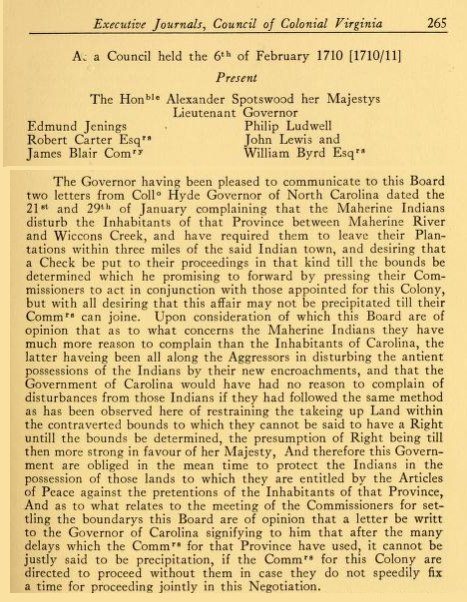
1711
The Surveyor John Lawson was put on trial and executed by the Tuscarora in the events that led up to the Tuscarora war. Barron de Graffen Reed, who witnessed this, said that a Meherrin man named Nick Major was a participating member of the Tuscarora Council.
(The Colonial Records
of North Carolina, Second Series – Volume VII – Records of the Executive Council – 1674-1734. pp 167-169)
“The council of “King” Hencock, which consisted of 40 elders, was called by the Tuscarora, according to De Graffenried, the “Assembly of the Great,” a translation of the Tuscarora terms for the council of chiefs, the general word for chief signifying ‘one is great, either in size or position. At the council before which Lawson and De Graffenried were tried the “forty elders” were seated around a great fire kindled in a large open space devoted to important festivals and public executions. On this occasion these chiefs and the accused were seated on rush mats, which were customarily provided for the comfort of guests as a mark of deference and honor.” “[They] had many dances suitable to various occasions; these as a rule were accompanied with public feasts prepared under the direction of the women chiefs. Every dance had its…. Song….” (Hodge, Frederick W. Handbook of American Indians, 1906.)
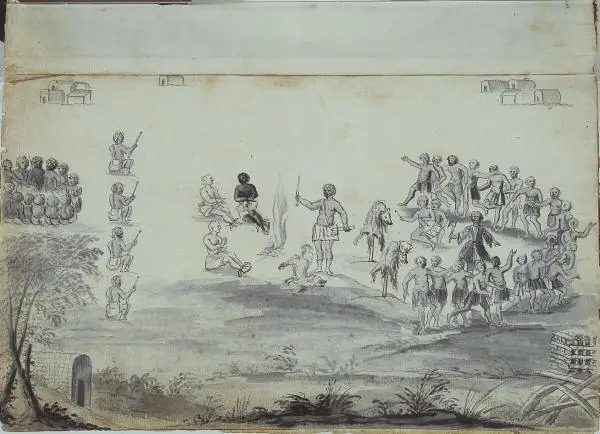
1711
Henry Briggs, who was the official interpreter to the Meherrin, Nottoway and testified that two Meherrin village names were “Cowinchehoccauk” and later, “Tawarra” at the mouth of the Meherrin River.
1711
Deposition of Henry Briggs, Indian Interpreter.
“Quest. 6. How long have year heard of Meherrin River & by what name has it gone by?
Ana. 6. About 28 years I have known it at Tawaro & severall other places & I never heard it called by any other name to this day but Maherrin.
Ques. 7. Where have the Meherrin Indians lived since you have known them?
Ans. 7. About 34 years agoe [ca. 1677] they lived at Cowinckehoccauk as I have been told by ye Indians, but the first time I was at theyr Towne, which was about 26 years agoe [ca. 1685], Tawarra, about 16 years [ca. 1695] they have lived at ye mouth of Maherrin River.”
Virginia M agazine of History and Biography (Stanard, ed.) VII(4), 1900: 351. October 3, 1711
1711
The Virginia Colony prohibited the Meherrin from communicating with the Tuscarora during the Tuscarora War. However, the Meherrin still aided the Tuscarora. (Rountree, Helen C. Pocahontas’s people: the Powhatan Indians of Virginia through four centuries.
University of Oklahoma Press, 1996.)
1711
Four “Maherines,” including a Mr. Thomas and his two sons, went north to buy
ammunition (Document B-38). Shortly thereafter “Mister Thomas” was “delivered up by the said Nation for corresponding with the Tuscaruros.” His sons were placed on probation until it was determined how they performed in battle against the Tuscarora under Capt. Hix.2
(The Secret History of the Meherrin page 92)
1711
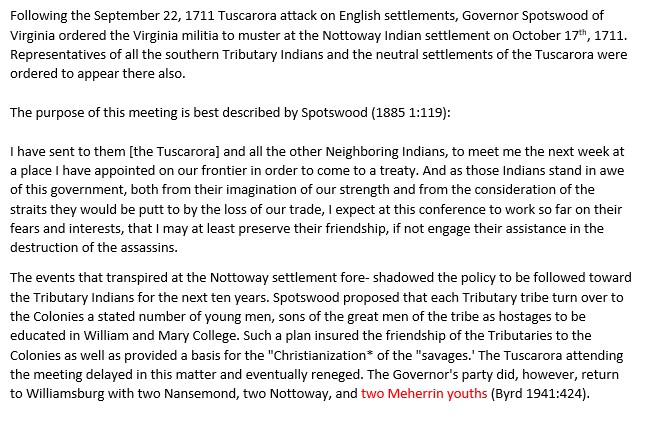
1711
CoL Spotswood to the Board of Trade
”… five o f the great men o f that nation [the Tuscarora] arrived very opportunely just at the time I had brought the Militia under some discipline… they w ere very much desirous to continue in peace with this Government and seemed much concerned that nay of their Nation should have joined in the Massacre in Carolina. I then proposed to them either to carry on a war against those Indians upon the promise of rewards to be paid them, o r to join with her
Majesty’s Subjects o f Carolina for extirpating those Assassins, and that for the better assuring us of their future good behaviours they should deliver two children o f the great men of each town to remain as Hostages and to be educated at our Colleges. But as they had no Authority to conclude anything without the concurrence of the rest o f their Nation, they desired time to informe their Townes and promised to retume with an Answer…
… yet I have prevailed so far by offering to remitt their whole tribute o f skins so long as they kept their children at the College, that the King of the Nansemonds has already sent his son and Cousin, the Nottoway and Maherines have sent each two o f their Chief mens sons to be brought up to Learning and Christianity…”
British Public Record Office, Board of Trade. Virginia. Vol. 13. O. 118. November 7, 1711
1711
…buying young Indian servants imported into the colony, until in 1711, Lieutenant Governor Spotswood hit upon a plan. He offered to remit the tribute of the poverty-stricken tribes if they would send some of their male children to the college. (291) The plan worked. Soon the Indian scholars included the reservation Nansemond “king’s” son and cousin, two sons each from the Nottoway and Meherrin councillors, the son of the “queen of Pamunkey,” with a boy each to serve him, and two other Pamunkey boys to be educated. The Chickahominies also apparently sent a child. (292) By the summer of 1712 there were twenty Indian boys at William and Mary. They had “a Master to teach them and are decently clothed and maintained, so that they seem very well pleased with the change of their condition as indeed their par-ents and others of their Nations who come frequently to see them, express much satisfaction with the care that is taken of them.” (293) The next year, when Spotswood made treaties with the Iroquoians of southern Virginia, the Nottoway, Meherrin, and Nansemond children were removed to Fort Christanna. (294)
Pocahontas’s People: The Powhatan Indians of Virginia Through Four Centuries
1711
Virginia’s Governor Spotswood had found it necessary to “send out Detachements of our Militias to prevent Our Tributary Indians joining with these Savages” (Spotswood 1882:117, letter to Council of Trade 3/6/1711). In another blatant effort to guarantee fidelity during the conflict, Spotswood arranged for two sons of the Meherrin chiefs men to be brought to the college at Williamsburg. He did not disguise his intentions to use the students as hostages, if necessary (1882:127, letter to Bishop of London, 11/11/1711). The Meherrin had been intimidated into a nominal alliance with the colonists.
(The Secret History of the Meherrin page 93)
1711
..several sorts of wearing Aparell belonging to the palatines lately settled in Carolina have been discovered among the Maheiine Indians which give just suspition that the sd Indians or some of them are concerned in the sd Malfiancc. It is thereupon ordered that a Detachment of the Militia of Nansemond Co. by forthwith sent to the Maherine Town to make search for such suspected goods and that upon discovery thereof they seize all the men of that Nation and send them under a guard to Wlmsburgh in order to be examined & txyed for the same and that all the Women & Children be likewise secured untill further order (British Public Record Office, Colonial Office 412/28, Sessional Papers 1709-1712; Virginia Colonial Records Project: SR 1476 (1605)/27:Reel #88, pp. 248-249; November 26, 1711, [my transcription]).
(The Secret History of the Meherrin page 93)
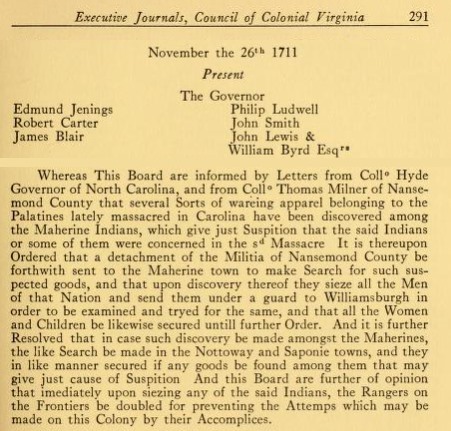
1711
Sessional Papers
“Whereas this board are informed by Letters from Collo. Hyde Governor of North Carolina and from Collo. Thomas Milner of Nansemond Co. that several sorts of wearing Aparell belonging to the palatines lately settled in Carolina have been discovered among the Maherine Indians which give just suspition that the sd Indians or some of them are concerned in the sd Malfrance. It is thereupon ordered that a Detachment o f the Militia o f Nansemond Co. by forthwith sent to the Maherine Town to make search for such suspected goods and that upon discovery thereof they seize all the men of that Nation and send them under a guard to Wmslburgh in order to be examined & tryed for the same and that all the Women & Children be likewise secured untill further order. And it is further resolved that in case such discovery be made amongst the Maherines the like search be made in the Nottoway and Saponie Towns, and they in like manner secured if any goods be found among them that may give just cause of suspition. And this board are further o f the opinion that imediately upon seizing any of the said Indians the Rangers on the Frontiers be doubled for preventing the attempts which may be made on this Colony by their Accomplices.”
British Public Record Office, Colonial Office 412/28, Sessional Papers 1709-1712; Virginia Colonial Records Project: SR 1476 (1605)/27: Reel £88, pp . 248-249; November 26, 1711.
1711
1711 Location of English and Indian Settlements.
An Ethnohistory of the Nottoway, Meherrin and Weanock Indians of Southeastern Virginia – Lewis R. Binford
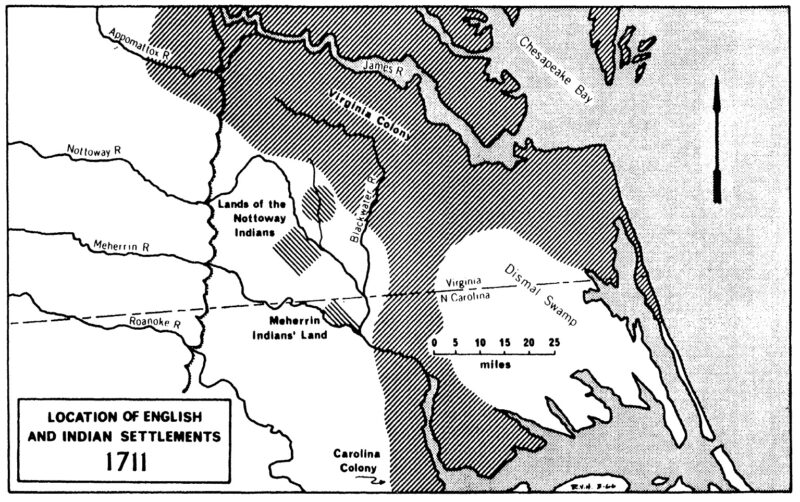
1712
April 16th, 1712.
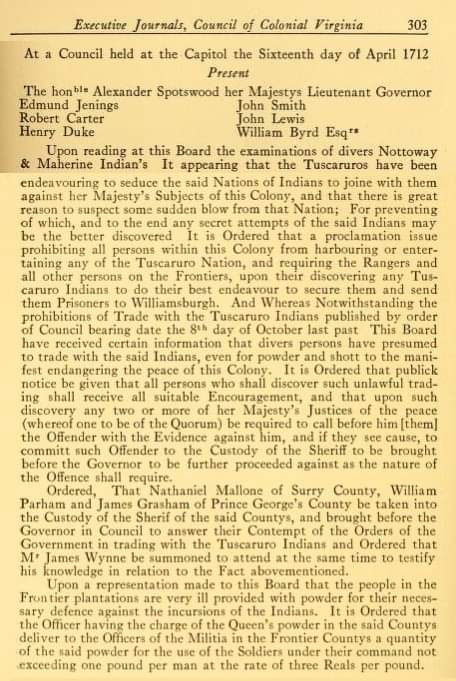
1712
We have it on the authority of the neutral Tuscarora leader:
Tom Blunt just now inforanes me of an Meherrin Indian lately at his towne, named Tut-sech, bas:queat [sic] – so that it is not to be doubted but that they supply them with what ammunition they use and cary what newes they know of… (Saunders, Vol. I, December 23, 1712, letter by Gov. Pollock)
This betrayal of the Meherrin by Blount no doubt set the stage for a retaliatory attack the
Meherrin later made on Blount’s town, kidnapping two children (Document B-48).
(The Secret History of the Meherrin page 93)
1712
North Carolina Colonial Records (Saunders) I: December 23, 1712
Letter by Gov. Pollock.
… I have often complaints brought to me of the insolency of the Meherrin Indians on this syde of Meherrin River, wth. a jealousy of their Killing and driveing back the peoples stocks, on John Beverly, who lives near them, against whom they have a great hatred, haveing had a mare or twoe shot lately – Also having ordered the Rangers and hunters, for to take upe any Indians they should meet with on this syde Meherrin River; and haveing taken on o f them, brought him in to the forsd. Beverlys- in a little time about eighteen of the Meherrin Indians came upe, most o f th a n armed and forced them to lett loose the indians they had taken, giveing them threatening and abusive language – so that besydes their Killing the peoples stocks, supplying the Tuscaroroes wth ammunition, I am in great doubt they may doe further mischief on this shore, and lay it on other Indians.
[in a postscript:]
Hond: Sr
Tom Blunt just now informes me of on Meherrin Indian lately at his towne, named Tut-sech, bas:queat so that it is not to be doubted but that they supply them with what ammunition they use and cary what newes they know o f wch I doubt not yr honor will consider.”
North Carolina Colonial Records (Saunders) I: December 23, 1712
1712
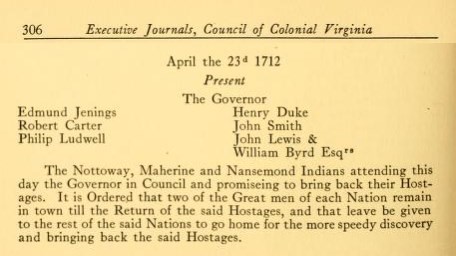
1712
Colonial Records of North Carolina
Letter from Thomas Pollock to [Alexander Spotswood] Pollock, Thomas, 1654-1722 December
23, 1712
I have ofteu complaints brought to me of the insolency of the Meherrin Indians on this syde Meherrin River, wth a jealousy of their Killing and driveing back the peoples stocks, on John Beverly, who lives near them, againstt whom they have a great hatred, haveing had a mare or twoe shot lately—Also having ordered the Rangers and hunters, for to take upe any Indians they should meet wth on this syde Meherrin River; and haveing taken on of them, brought him in to the for sd Beverlys—in a little time about eighteen of the Meherrin Indians came upe, most of them armed and forced them to lett loose the indians they had taken, giveing them threatening and abusive language—so that besydes their Killing the peoples stocks, supplying the Tuscaroroes wth ammunition, i am in great doubt they may doe further mischeif on this shore, and lay it on other indians—All wch I hope yr: honor will either redress; or not take offence If wee take such measures wth them as wee shall see most for our own safty—Tom Blunt, the indian comeing in befor I had finished hath hindered my sending thes two dayes, so that i beleive if the boat or cannoe for the duffells be at Mr Cottons by Wednesday the last of this month, it may be time enough—Coll: Moore hath promised Tom Blunt, (upon his being true to the English) protection, and to secure him and the people of his Fort from his indians—Tom Blunt is very desirous of having in, his brother (as he cals him) and his cousine now in your prison, whom the Bearer Wm Charleton our interpreter knows—whom if your honor will be so favourable as to let us have them sent to Mr Cottons, to be brought downe in our boat it will be a great Kindness, and may be of great service to us, Blunt accusing us, for giveing him nothing for all he is done only words, as he says—He had intended to have come or sent in now, to yr: honor, But Coll: Moore intending to march in by his towne, he thought it necessary for him to be at his towne; of all wch our interpreter can give you a full account—
(Colonial Native Dispossession of North Carolina Researched by: Baylus C. Brooks Research Assistant: Julie S. Brooks. Page 12-13)
1712
Letter of Governor Thomas Pollock, 1712 Dec. 23.
Contains a letter from Governor Thomas Pollock, President of North Carolina, to [Lieutenant Governor Alexander Spotswood], regarding the poor state of the colony, the scarcity of provisions for the troops under Col. [James] Moore in his expedition against the Tuscaroras, the need for troops from Virginia, complaints against the Meherrin Indians, and the protection of [Chief] Tom Blunt.
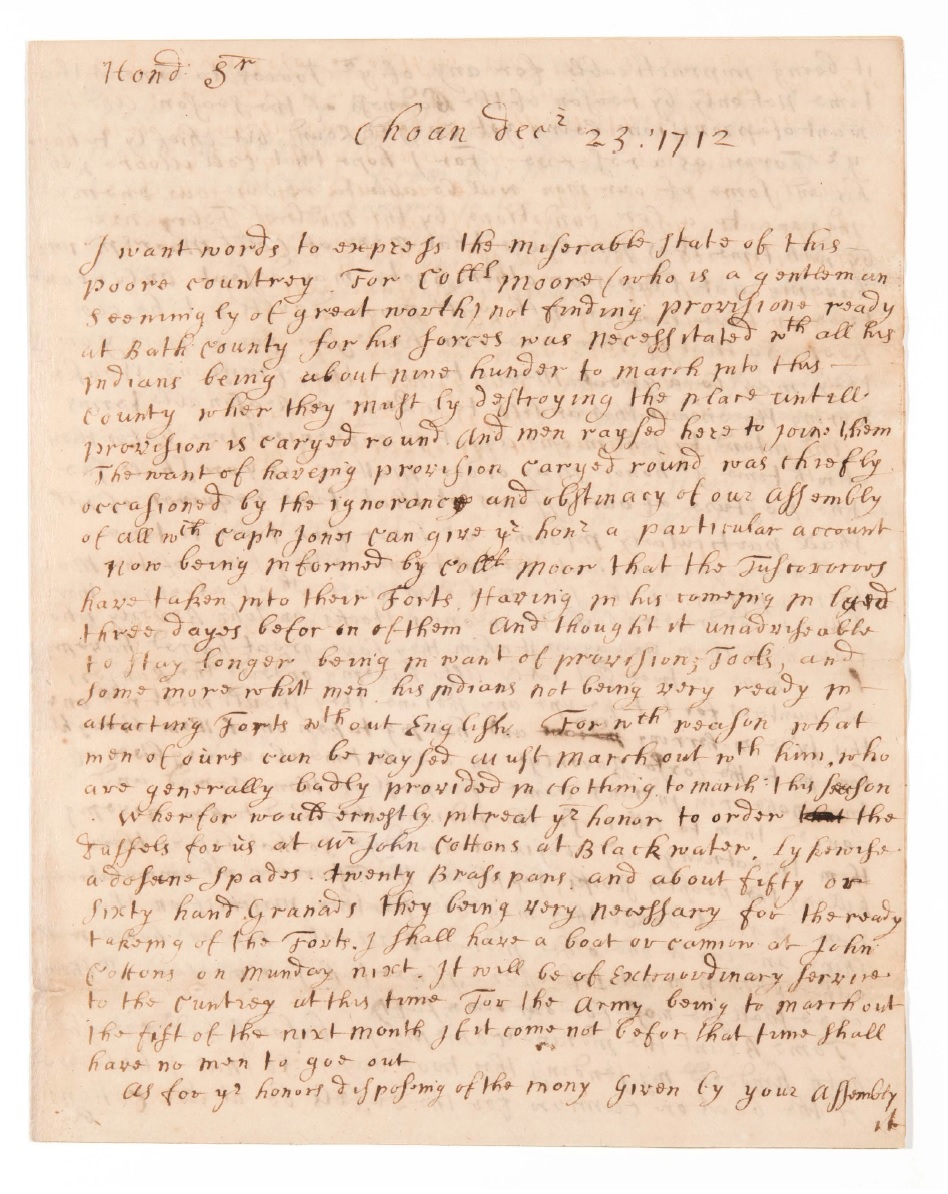
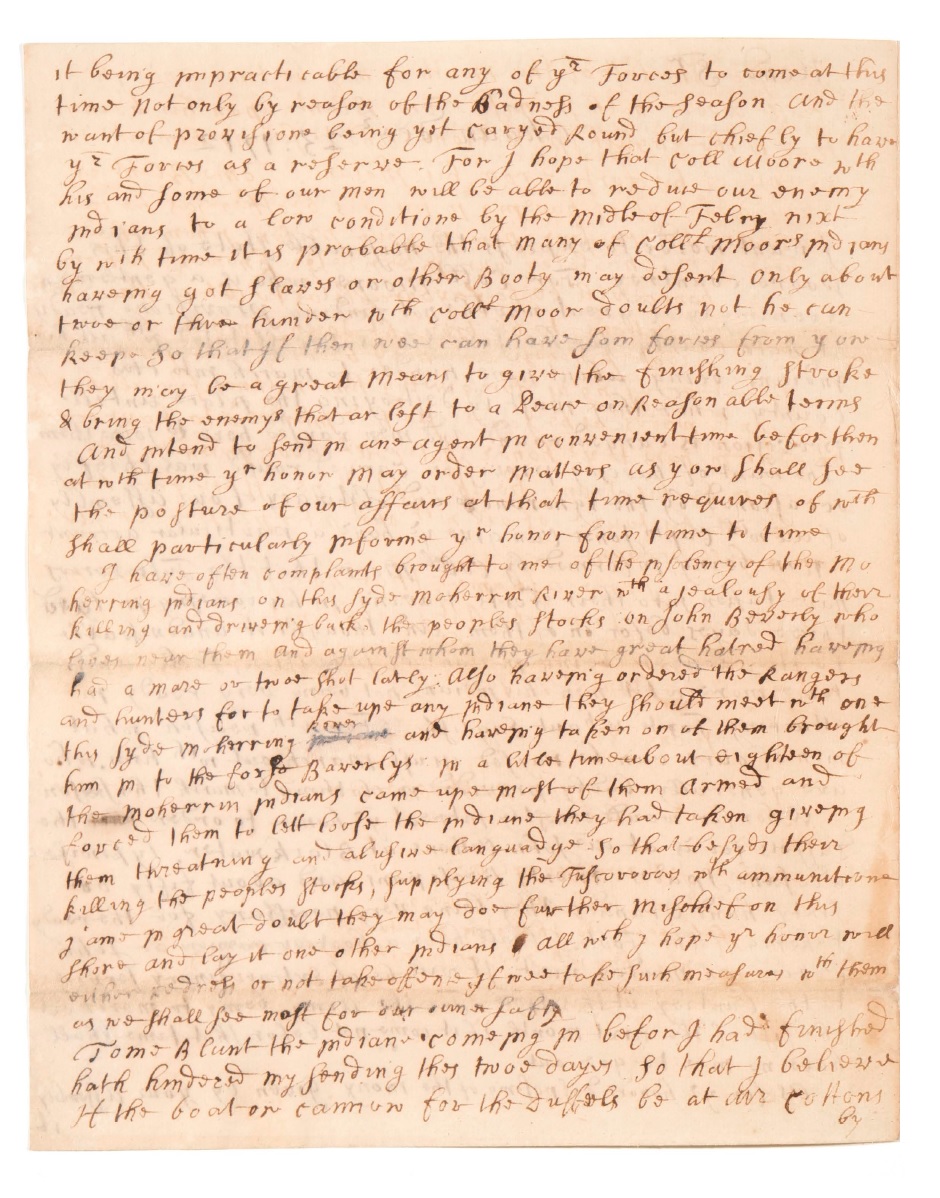
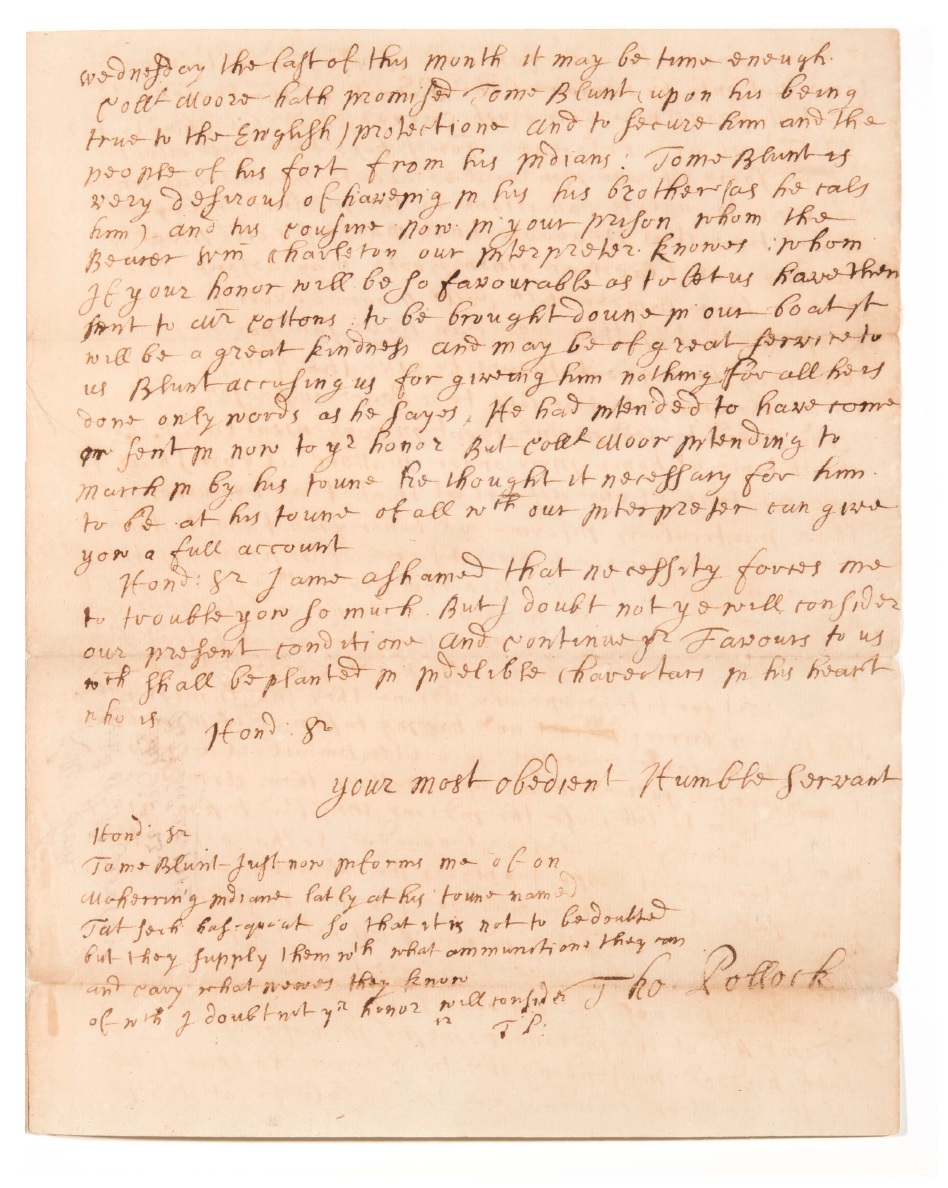
1712
The Meherrin were noted as being tributary Indians to Colony Virginia. Several of the colonists transported the Meherrins to pay tribute, and petitioned to be reimbursed for their expenses
(Virginia Colonial Records).
1712
A yellow fever epidemic swept North Carolina in 1712 (Hawks 1858) and may very well have
struck the Meherrin;
(The Secret History of the Meherrin page 96)
1712
“The Nottoway, Maherine and Nansemond Indians attending this day the Governor in Council and promiseing to bring back their Hostages. It is Ordered that two of the Great men of each Nation remain in town till the Return of the said Hostages.”
Executive Journals o f Council (Mcllwaine), Vol III: 306. April 23 ,1712 .
1712
Jan 30, 1712.
Meherrin man named John Querro.
Note: Querro is how the English recorded the name Kwè·ruʔ which translates to Rabbit.
Note: It’s highly probable that John Querro might have been a son or descendant of Meherrin Chief Ununtequero who signed the 1677/1680 Treaty
Calendar of Virginia state papers and other manuscripts
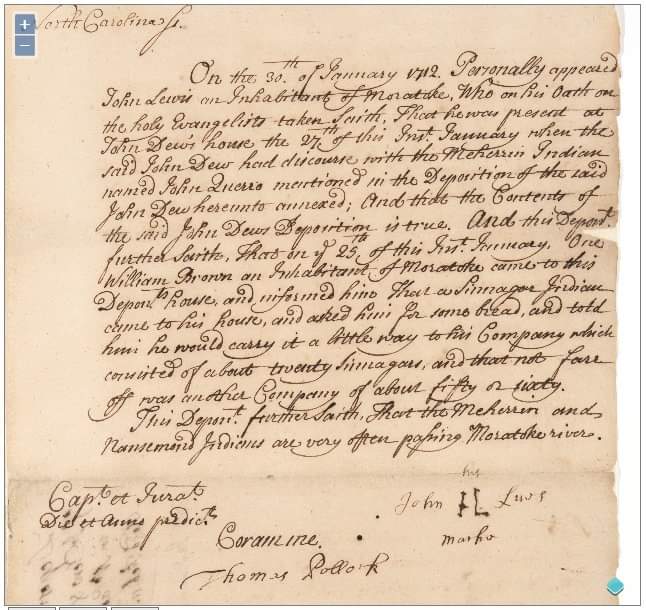
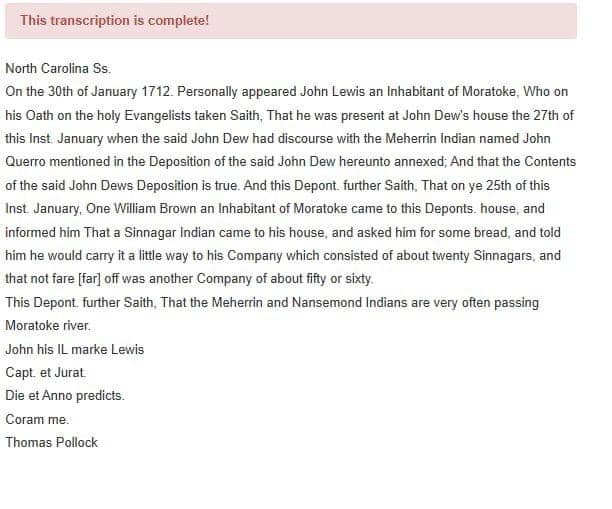
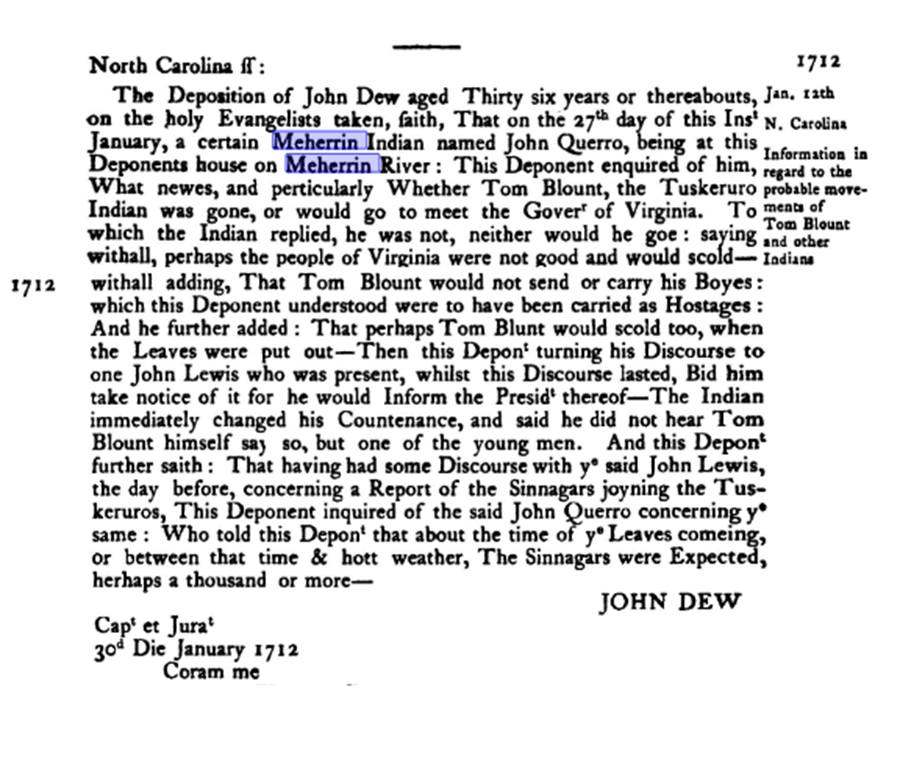
1712
Letter from Governor Pollock to Governor of South Carolina
“as for the Meherrins… there is no trust to be put in them.”
North Carolina Colonial Records (Saunders) I: 884. October 1712
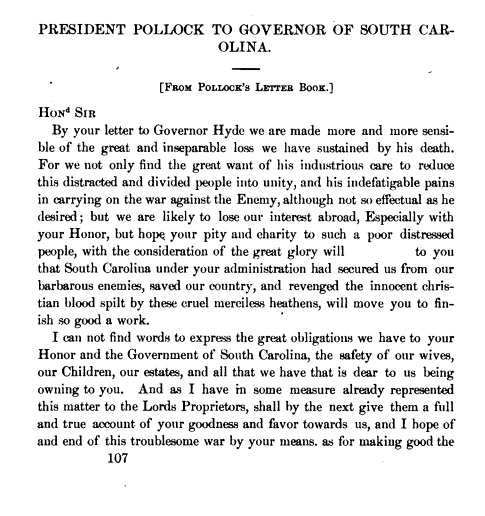
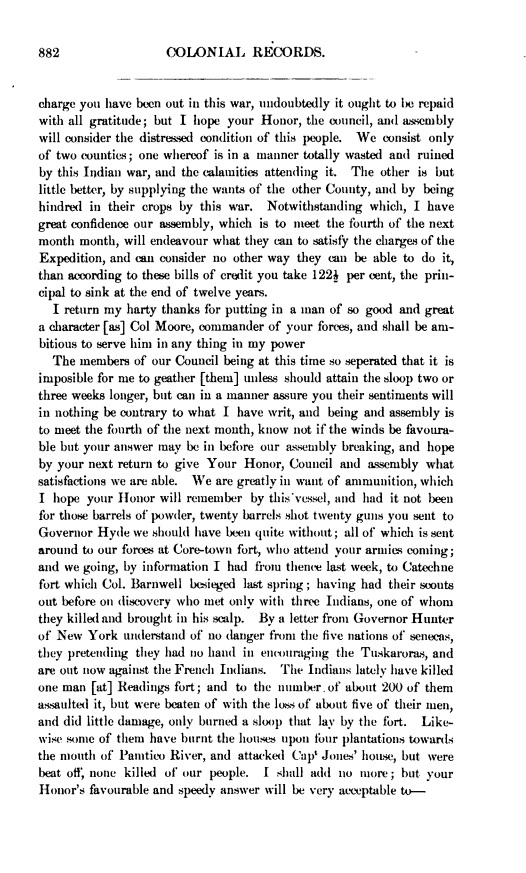
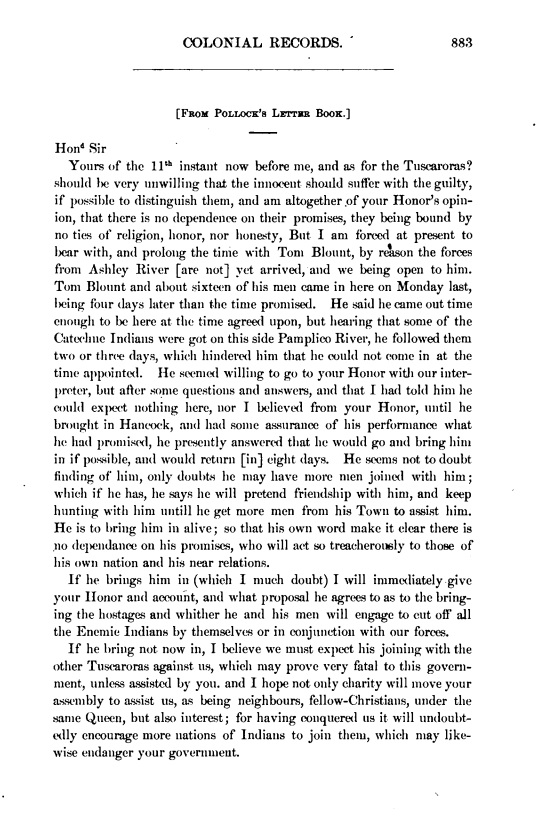
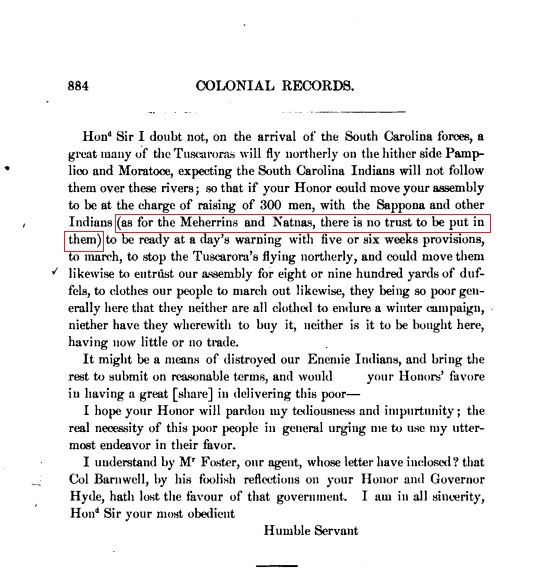
1712
Letter to Gov. Pollock from Williamsburg.
“.. I intended to deliver up to you all the Indian prisoners that are here: among wch. there are now two Waccon Indians taken lately by the Meherins in pursuance to my orders…”
North Carolina Colonial Records (Saunders) I: 891. December 13, 1712.
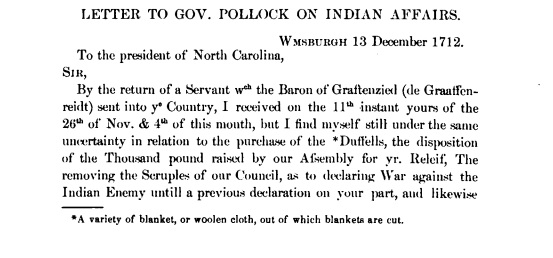
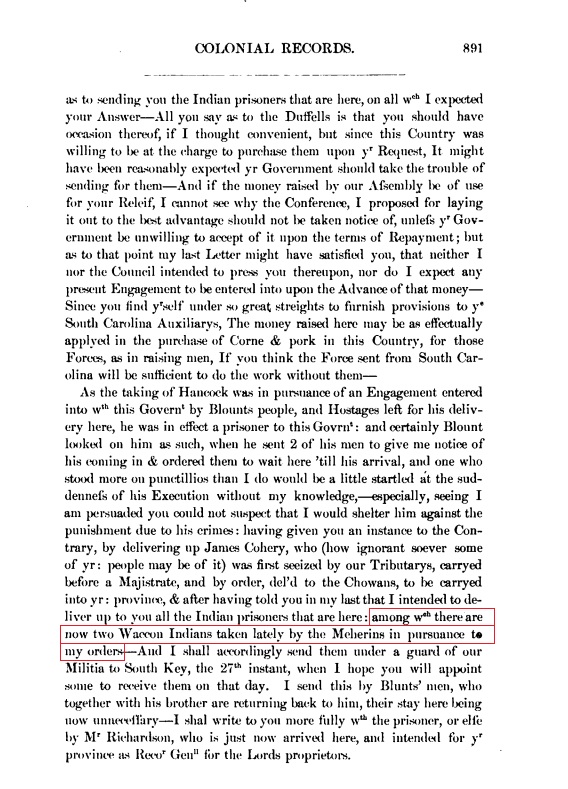
1712
Dec 13, 1712 Letter of Lieutenant Governor Alexander Spotswood.
Contains a draft of a letter from Lieutenant Governor Alexander Spotswood, Williamsburg, to Col. [Thomas] Pollock, President of North Carolina, regarding Indian affairs and money raised by the Assembly for the relief of North Carolina. In addition, Spotswood writes concerning Chief Blunt and the execution of Chief Hancock, one of the leaders of the Tuscarora Indian massacre in North Carolina and two Waccon Indians taken prisoner by the Meherrin Indians.
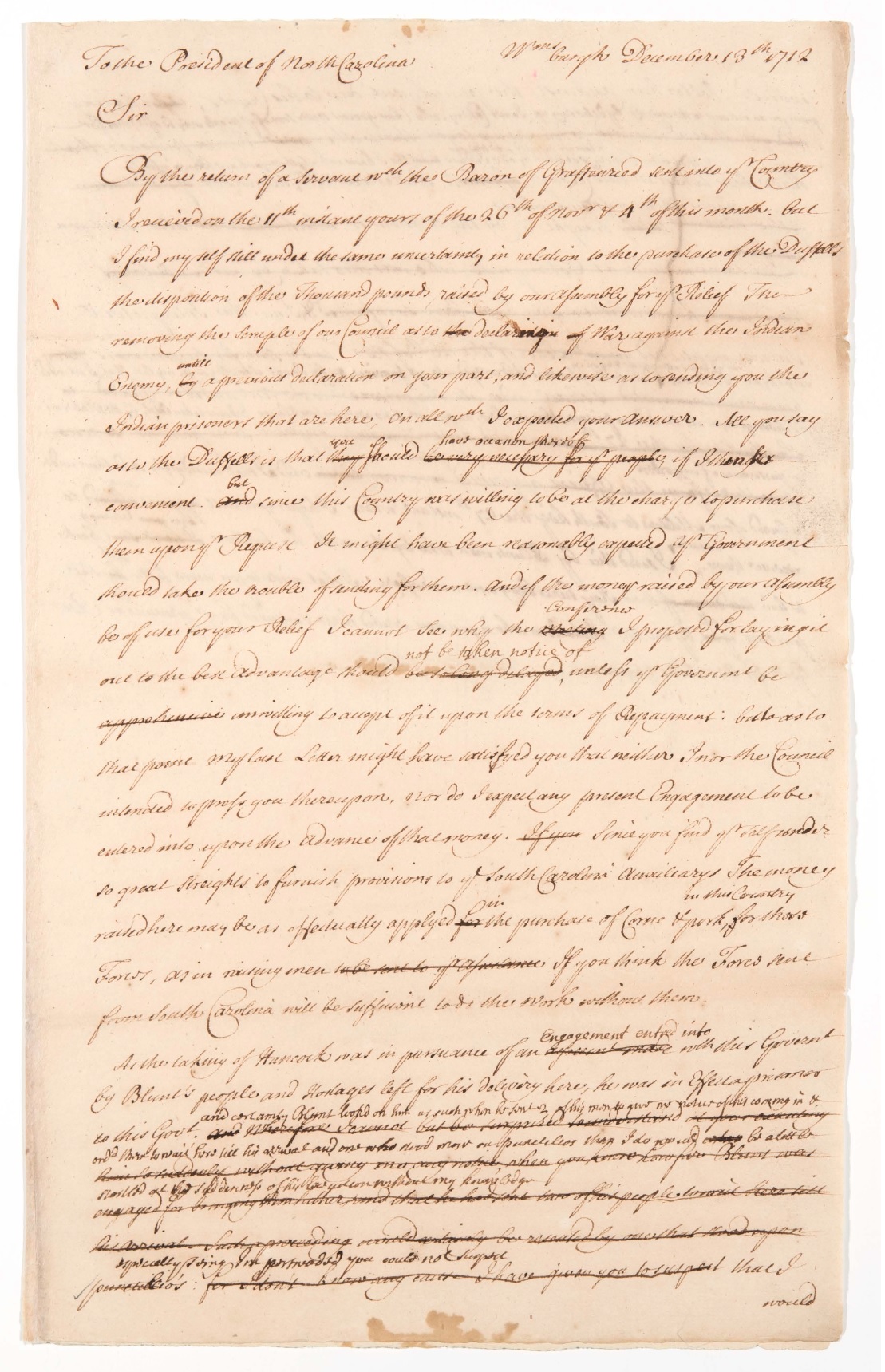
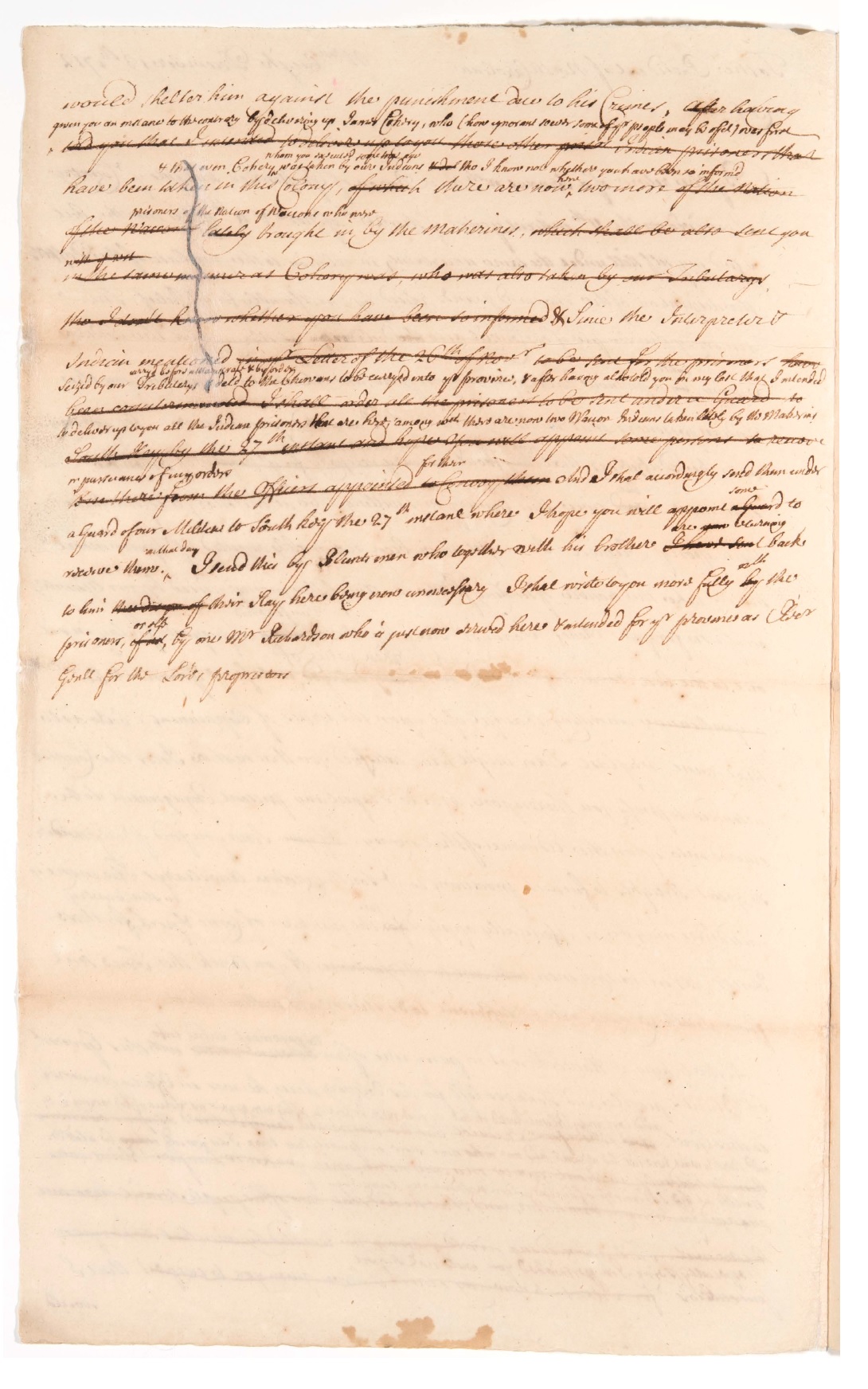
1712
Letter to Gov. Pollock from Williamsburg.
“.. I intended to deliver up to you all the Indian prisoners that are here: among wch. there are now two Waccon Indians taken lately by the Meherins in pursuance to my orders…”
North Carolina Colonial Records (Saunders) I: 891. December 13, 1712.
1712
In 1712 some of the Meherrin were given protection by the Five Nations.
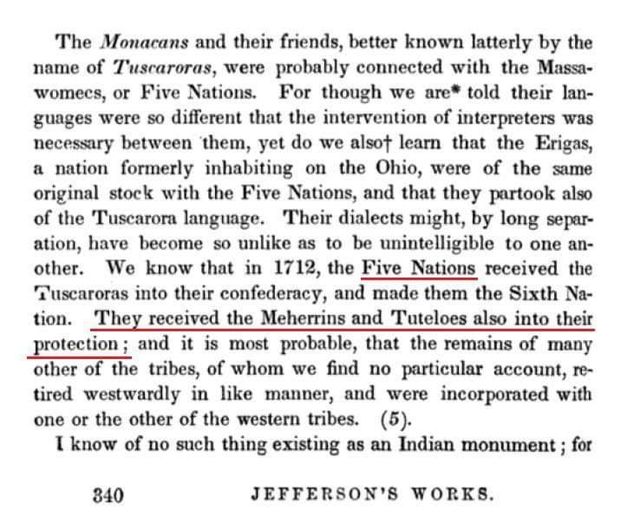
1713
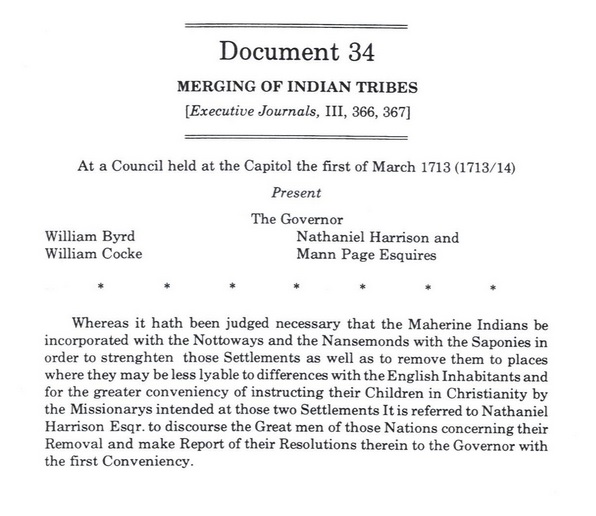
1713
“Information being given to this Board that sundry Tracts of strange Indians have been discovered on the Frontiers of the Countys of Surry and Isle of Wight…And that for the better pursuing the Tract of the said strange Indians, ten of the Maherine and Nansemond Indians be appointed to joine the detachment from Isle of Wight, and a like number of the Nottoway Indians to joine the detachment from Surry County…”
Virginia Executive Journals of Council (Mcllwaine), Vol. I ll: May 2 ,1713 .
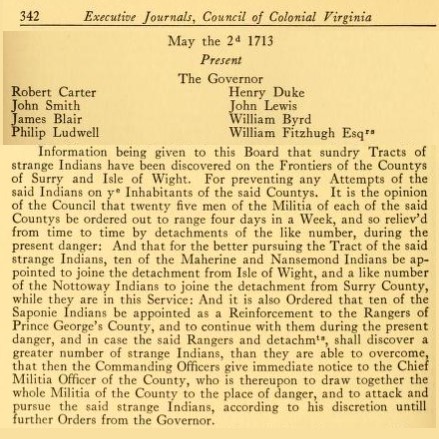
1713
August 7, 1713.
Its is ordered by this board, that the Honorable the President be full empowered to treat with the Meherrin Indians, and to enter into such articles or agreements with them, on behalf of this government, as he shall think fit.
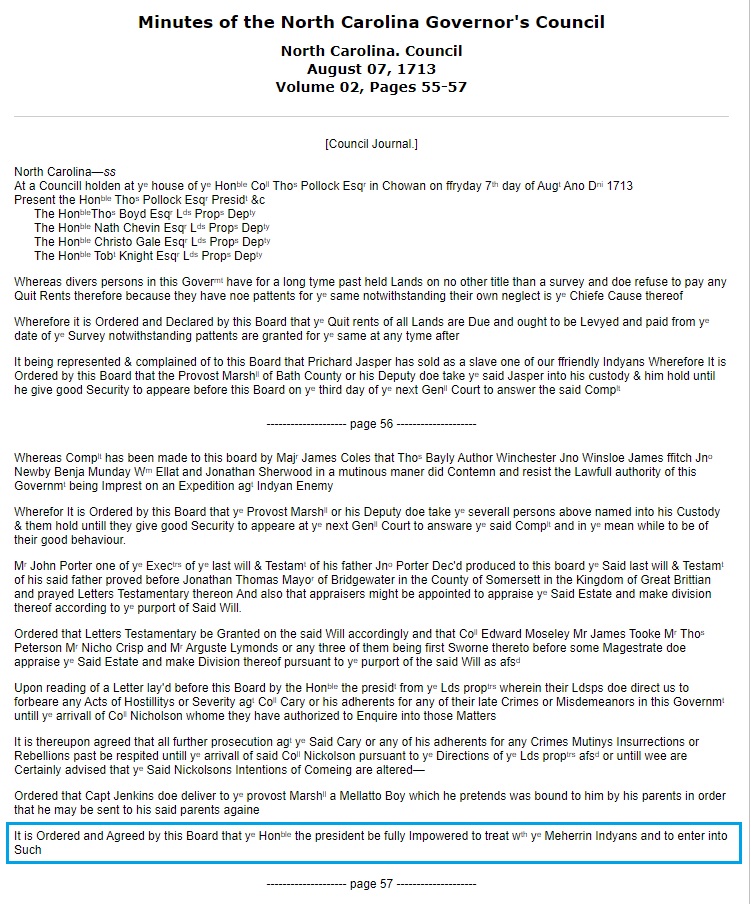
1713
“A Maherine Indian named Mister Thomas being pursuant to the Governor’s Orders delivered up by the said Nation for corresponding with the Tuscaruros; And on his examination alledging that he was taken and carry ed prisoner by the said Tuscaruros against his Will. It is Ordered that he be delivered to the Greatmen of the said Maherine town to be kept by them, untill it appear how his two Sons who are lately gone in the expedition under the command o f Capt. Hix shall behave themselves, Or that further proof be made that the said Mister Thomas his Correspondence with the Tuscaruros was involuntary as he pretends.
“The Great men of the Maherine Indians this day representing to the Governor in Council that the President o f North Carolina hath not only demanded Tribute of them, but hath sent his Orders to command their men to assist that Government, as if they were Tributarys thereto, It is the Opinion o f the Council that the said Indians ought not to acknowledge any Subjection to the Government of Carolina, they having been constantly Tributarys to Virginia since the Treat o f Peace made at Middle plantation in the year 1677, and living within the bounds claimed by Virginia. And It is Ordered that the said Indians do not obey any Summons sent them by the Government of Carolina, nor furnish any men upon such summons without the License o f the Governor o f this Colony first obtained for so doing.”
Virginia Executive Journals o f Council (Mcllwaine) 111:352. October 16,1713
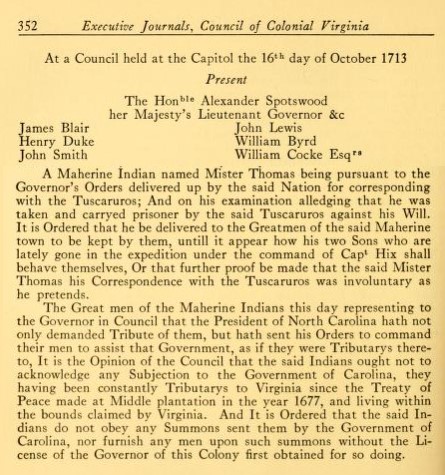
1713
Letter from Col Pollock to Spotswood
…”as for the Meherrin Indians, you have had wrong information concerning them: for they have answered to our Courts, they have submitted themselves to this government, they have paid tribute here; so that they have not always been accounted in your government; but, on the contrary, have always here been taken to be in this; and it was only the convenience of trade that drew them to submit to yours… As for your Honor’s acquainting us that we may not expect any assistance of men from the Meherrins, and that you have ordered them not to acknowledge our government… We have had nothing of moment worth communicating to you these several months last past, only that some scattered parties of our enemies do still distress us out of their swamps and lurking-places, killing many of our people…”
North Carolina Colonial Records (Saunders) II: 73-74. November 16, 1713.
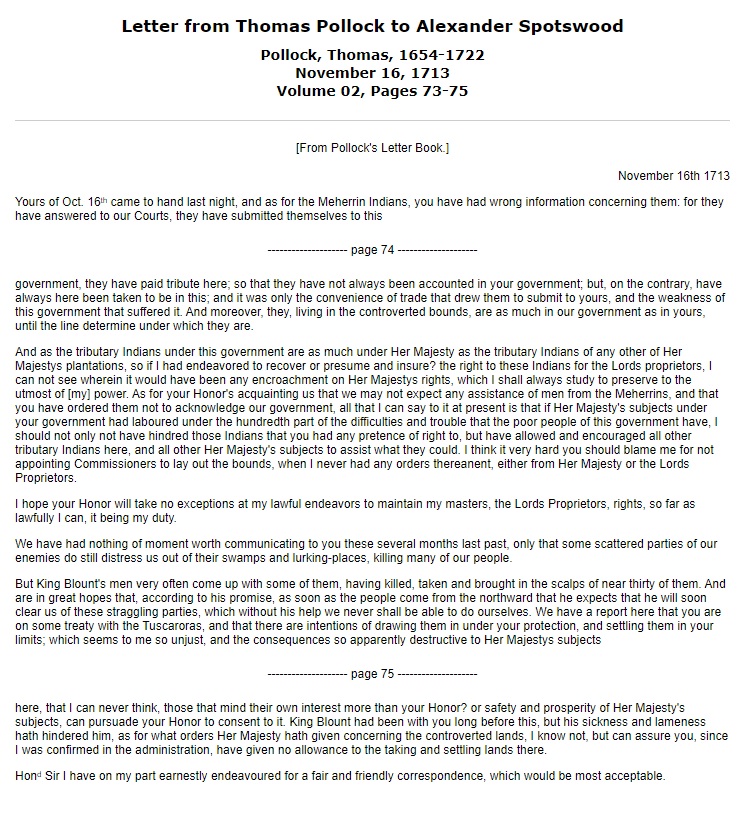
1713
Letter of Lieutenant Governor Alexander Spotswood, 1713 Dec. 16.
A draft of a letter from Lieutenant Governor Alexander Spotswood, Williamsburg, to Col. [Thomas] Pollock, President of North Carolina, regarding the defense of Pollock’s claim that he acted unjustly and misapplied the money given for North Carolina’s assistance. Spotswood threatens to not respond to any further letters which contain false accusations against him. In addition, Spotswood complains of the interference of North Carolina with the Meherrin Indians, Tributary Indians in Virginia, who were called away into North Carolina while they are under the protection of the Colony of Virginia. Lastly, Spotswood further defends himself by stating that he has encouraged the Tributary Indians to be educated in the Christain faith.
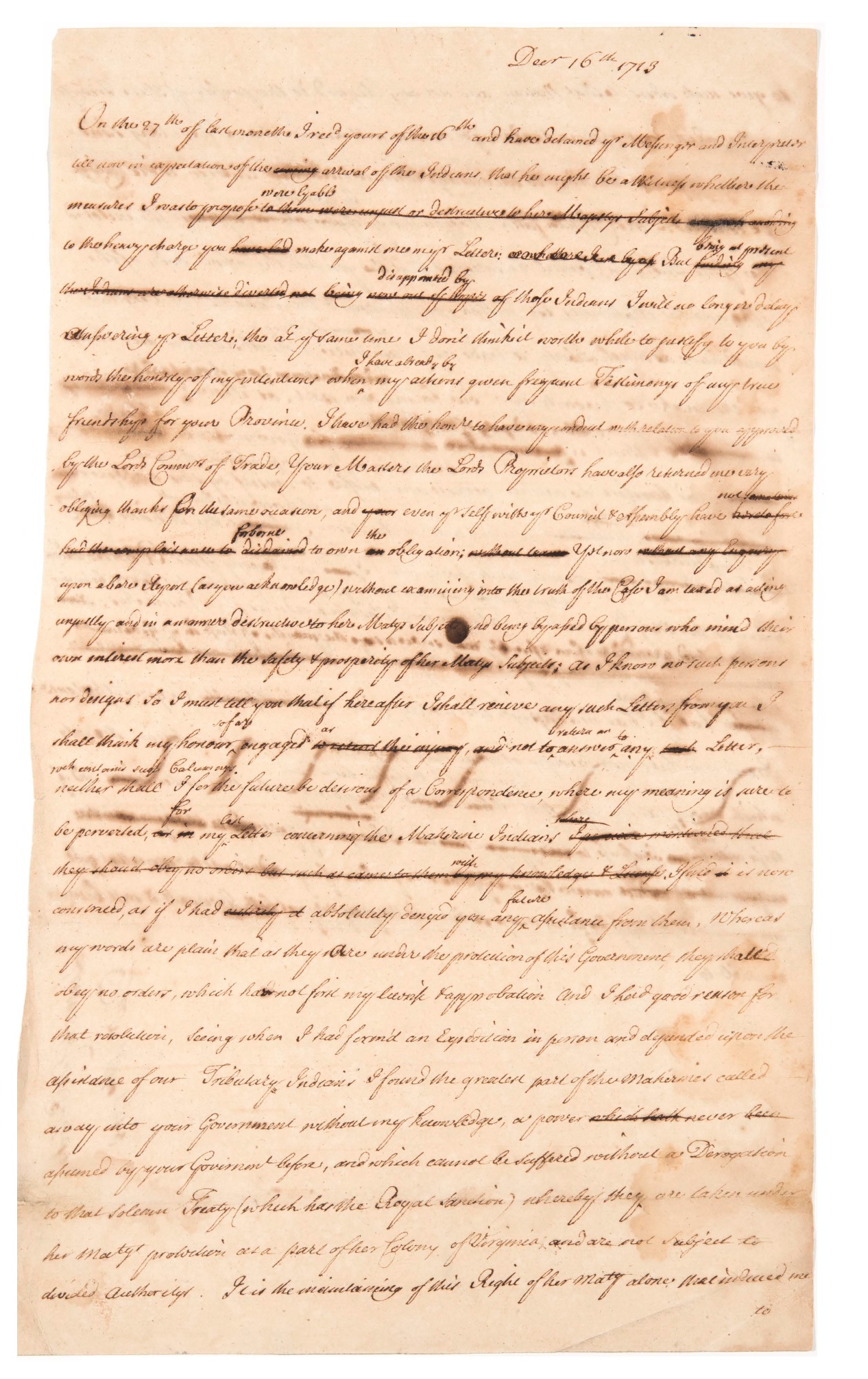
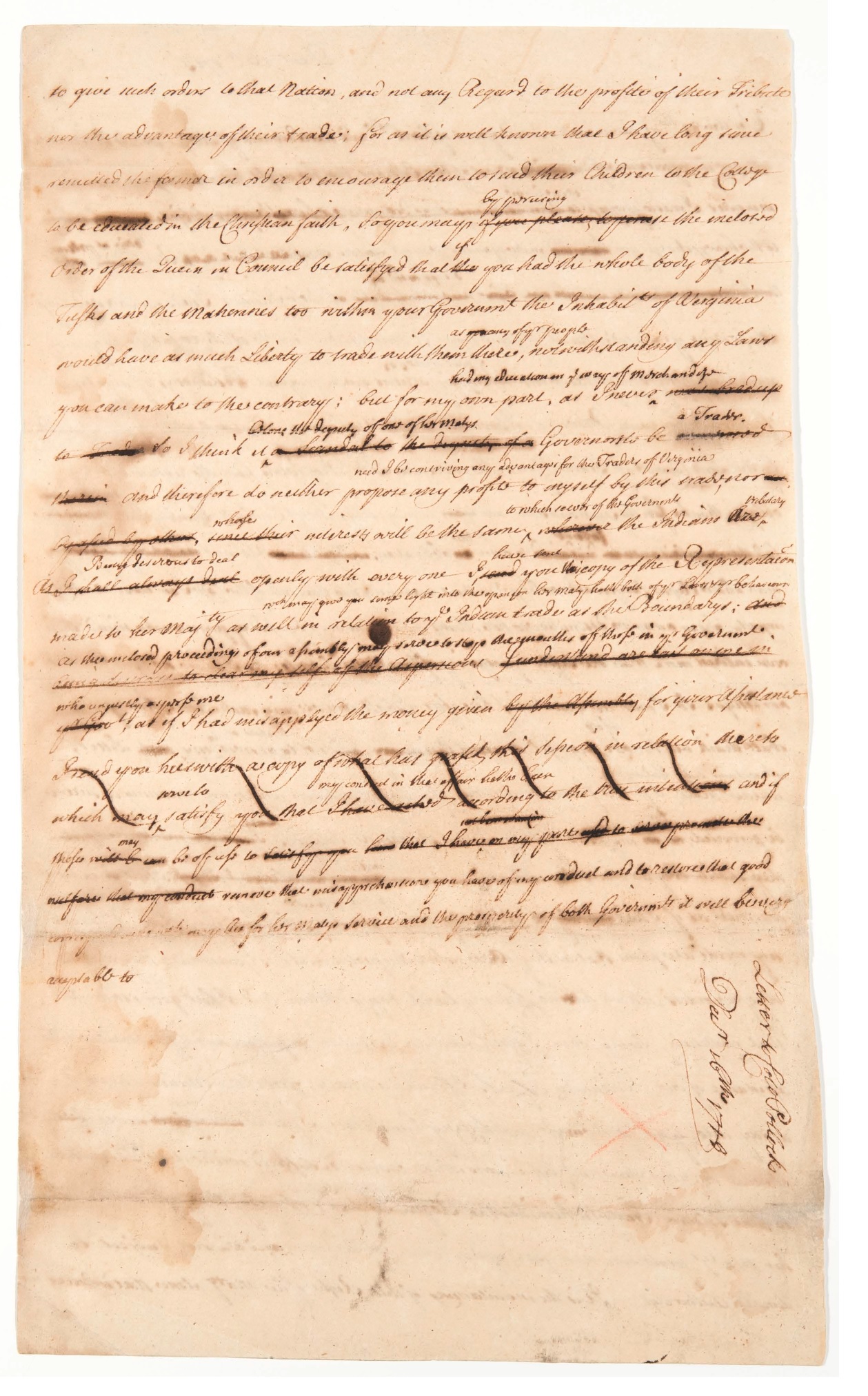
Decr 16th 1713
On the 28th of last moneth I recd yours of the 16th and have detained yr Messenger and Interpreter till now in
expectation of the arrival of the Indians that he might be a Witness whether the measures I was to propose
were lyable to the [heavy?] charge you make against me in yr Letter: But being at present disappointed by
those Indians I will no longer delay Answering yr Letter; tho at ye same time I don’t think it worth while to
justify to you by words the honesty of my intentions when I have already by my actions given frequent
Testimonys of my true friendship for your Province. I have had the honr to have my conduct with relation to
you approved by the Lords Commrs of Trade, Your Masters the Lords Proprietors have also returned me very
obliging thanks for the same occasion, and even yr self with yr Council & Assembly have not forborne to own
the obligation; Yet now upon a bare Report (as you acknowledge) without examining into the truth of the Case
I am taxed as acting unjustly and in a manner destructive to her Matys Subjects and being byassed by persons
who mind their own interest more than the safety & prosperity of her Matys Subjects; As I know no such
persons nor designs So I must tell you that if hereafter I shall receive any such Letters from you I shall think
my honour so far engaged as not to return an answer to any Letter, wch contains such Calumnys neither shall I
for the future be desirous of a Correspondence, where my meaning is sure to be perverted, for my last Letter
concerning the Maherine [Meherrin] Indians. I find it now constructed, as if I had absolutely denyed you any
future Assistance from them, Whereas my words are plain that as they Are under the protection of this
Government, they shall obey no orders, which have not first my [license?] & approbation And I had good
reason for that resolution, Seeing when I had form’d an Expedition in person and depended upon the assistance
of our Tributary Indians I found the greatest part of the Maherines called away into your Government without
my knowledge, a power never assumed by your Governmt before, and which cannot be suffered without a
Derogation to that solemn Treaty (which has the Royal Sanction) whereby they are taken under her Matys
protection at a part of her Colony of Virginia and are not Subject to divided Authoritys. It is the maintaining of
this Right of her Maty alone that induced me to to give such orders to that Nation, and not any Regard to the
profite of their Tribute nor the advantage of their trade; for as it is well known that I have long since remitted the
former in order to encourage them to send their Children to the College to be educated in the Christian faith,
So you may by perusing the enclosed Order
of the Queen in Council be satisfyed that if you had the whole body of the Tusks [Tuscaroras] and the
Maherines too within your Governmt the Inhabitts of Virginia would have as much Liberty to trade with them
there, as any of yr people, notwithstanding any Laws you can make to the contrary: but for my own part, as I
never had my education in ye ways of Merchandise So I think it [below?] the [dignity?] of one of her Matys
Governors to be a Trader. and therefore do neither propose any profite to myself by this trade, nor need I be
contriving any advantages for the Traders of Virginia whose interests will be the same to which so ever of the
Governmts the Indians Tributary Being desirous to deal openly with every one I have sent you this copy of the
Representacon made to her Majty as well in relaton to ye Indian trade as the Boundarys wch may give you
some light into the opinion her Maty holds both of yr Letrs & yr behaviour; as the enclosed proceedings of our
assembly may serve to stop the mouths of those in yr Governmt who unjustly despise me, as if I had
misapplyed the money given for your Assistance and if those may be of use to remove that misapprehention
you have of my conduct and to restore that good [correspondence?] wch may Act for her Matys Service and
the prosperity of both Governmts it will be very acceptable to
[on another panel]
Letter to Colo Pollock
Decr 16th 1713
1714
Journal of North Carolina Council* Complaint of King Blount
“the Meherrin Indians having taken two Indian children belonging to the said Blount… and do detain the same as slaves; wherefore this resolved by this Board that the President do write to the said Meherrin Indians commanding them to deliver the said Indians as they shall answer the contrary at their peril; and upon refusal, that the President do take such further measures as he shall think fit to compell them thereto.”
North Carolina Colonial Records (Saunders) II: 117. January 23 ,1714
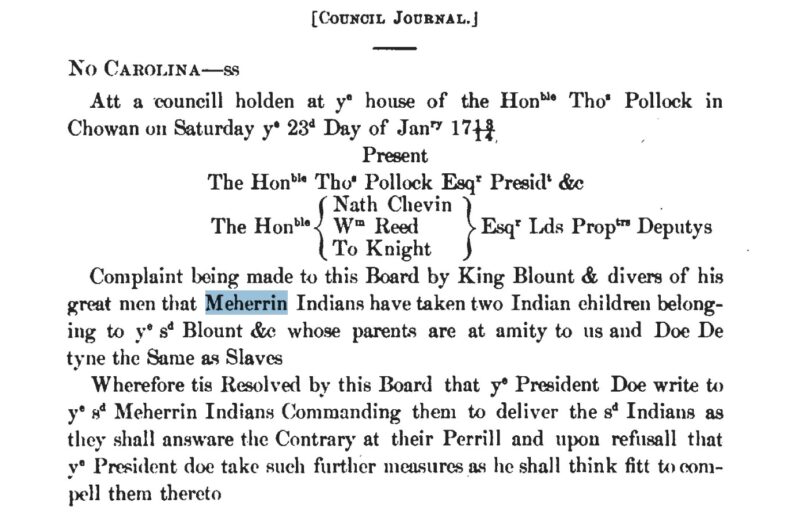
1714
Indian treaty agreements at close of Tuscarora War.
“After which the Governor was pleased to communicate to the Council the Scheme he had framed for the Settlement of the Indians and the Security of the Frontiers Which is as follows Viz. That the Maharines be incorporated with the Nottoways and Settled upon Roanoak River with a party of twelve English men to reside among them, who shall observe all their motions and some of them to go out constantly with their hunting Parties and that the grounds for their hunting be assigned them between Roanoak River and Appomattox. That this Settlement consisting of a considerable body of Indians would serve as a good Barrier to the Inhabitants against the Southern Indians, whose incursions are now most to be dreaded…”
Virginia Executive Journals of Council (Mcllwaine) III: 362-366. January 27 ,1714 .
1714
Jan 27th, 1714
Gov Alexander Spostwood’s “scheme” to control the Indians”.
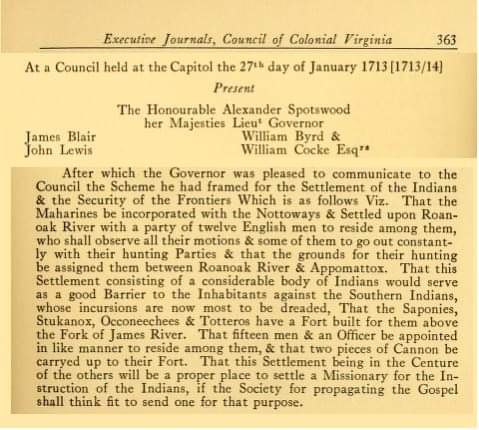
1714
March 1, 1714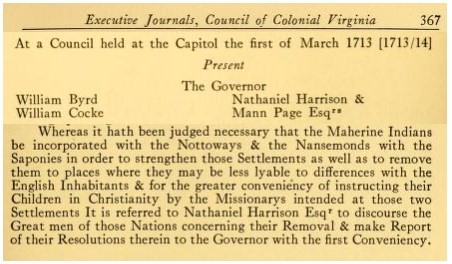
1714
In 1714 Spotswood himself visited the site and successfully persuaded the Siouan tribes, who included the Saponi, Tutelo, Occaneechi, and Nahyssan, to occupy the tract that was surveyed. However, the Iroquoian tribes in Virginia, the Nottoway and Meherrin, refused to take up their portion, saying they would not live with the Siouans. Spotswood even contemplated abducting them to make them live at the fort, but they eluded all efforts
1714
“The Governor acquainted the Council that pursuant to the Trust reposed in him by the General Assembly he had for the better securing the Frontiers erected a Fort at Christanna on the South side of Maherine River… and on the opposite Side of the River another Tract for the Nottoways
and Maherines who had represented to him the impossibility of their being able to Subsist on the Land intended for them in the fork of James River, by reason of its barrenness, of which he himself had been an eye witness during his late Progress.”
Virginia Executive Journals of Council (Mcllwaine) III: 375-376. October 15 ,1714
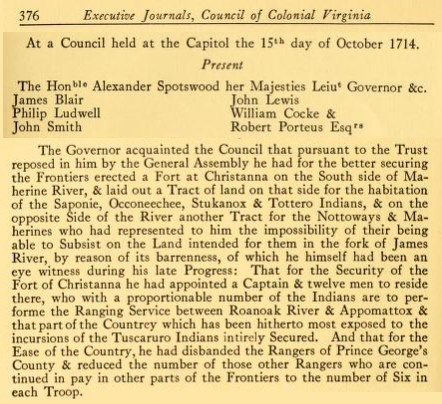
1714
Fort Christanna- A thirty six square mile (23,040 acres) tract of land was laid out on both sides of Meherrin River, in present-day Brunswick County, Virginia, as a Reservation for “friendly Indians.” The Siouan nations: the Sapony, Occoneechee, Stuckanox, and Tutelo were assigned the south side of the river. The Iroqouis Nations: the Nottoways and Meherrins were told to settle on the north. As the Iroquois and Siouan Indians were age-old enemies, conflict would only ensue. The Meherrin refused to move there and remained in their villages.
1715
“Whereas the Maherine Indians have removed off the lands assigned them by the Articles of Peace in 1677 and settled at the mouth of Maherine River in the bounds now in Controversy between this Colony and Carolina, and by their frequent disobedience to the orders of this
Government, have given just cause to suspect their future behaviour. It is therefore the opinion of the Council that the Governor take a suitable time to order the Removal of the said Maherine Indians to Christanna, where they may be under the command of the Fort there; and that in case the said Indians shall refuse to remove they be compelled thereto by seizing their wives and Children, to be conveyed to Christanna aforesaid, and put under the care of the guard there untill such time as the said Indians shall Voluntarily remove themselves to the land which shall be assigned them there.”
Virginia Executive Journals of Council (Mcllwaine) III: 395-396. February 23 ,1715
1715
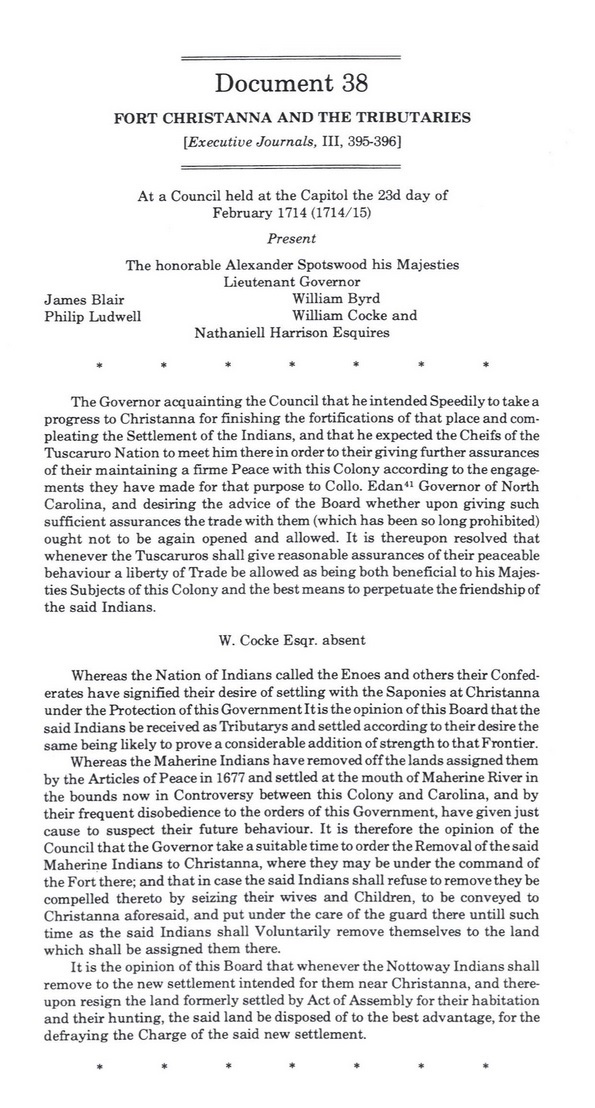
1715
On April 25, 1715 the Virginia Council met to discuss a plan to seize the wives and children of the Meherrin and send them to Fort Christanna to be put under guard at the Fort until the Meherrin volunteered to move there.
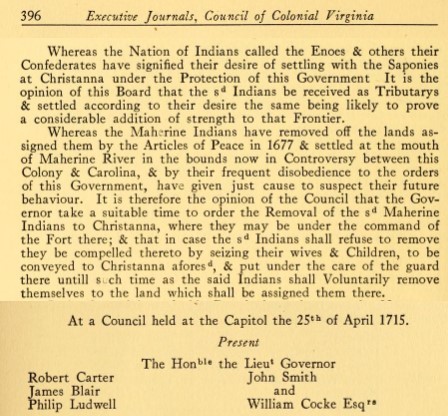
1715
“The Governor further acquainted the Council that the Senequa Indians have lately signified their inclination to renew their Treaties of Peace with this Government and its Tributaries by sending him a Belt (as their custom is) and offering to come in with one another upon the return of another Belt from hence, he had judged it expedient for the better establishing a Peace with that nation in order all the Nations of Indians Tributary to this Government to join in making the sd. Belt & intended to dispatch it hither by some of the Nottoways and Maherines.”
Virginia Executive Journals of Council (Mcllwaine) 111:397-398. April 25, 1715.
1715
May 31st, 1715.
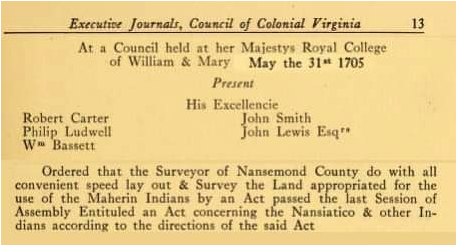
1715
“… one Nathaniel Tatum hath entertained a Tuscaruro Indian named Tony who has been suspected of poisoning divers Indians & hath lately threatned to poyson some of his Majesties Subjects. It is orderd that the Sheriff of Surry County forthwith take the sd Tuscaruro Indian into his custody & cause him to be conveyed to the Great men of the Maherine Indians either to be punished by th a n according to their Laws for his poysoning one of that Nation or to be by than delivered up to his own Nation to be dealt with as they shall think fitt. And it is ordered that the sd Tatum pay the Charge of conveying the sd Indian to the Maherine Town, or else that he be prosecuted upon the late Act of Assembly for entertaining the sd Indian without a Passport.”
Virginia Executive Journals of Council (Mcllwaine) III: 407. August 12, 1715
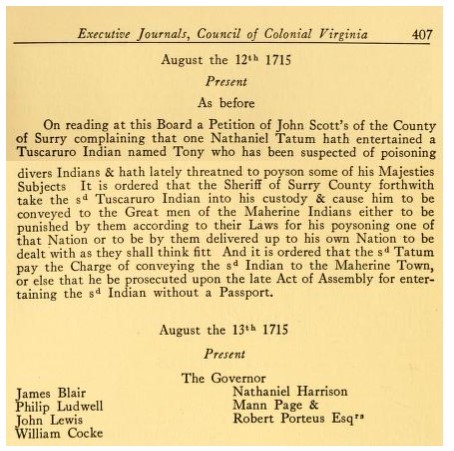
1715
Nov 17, 1715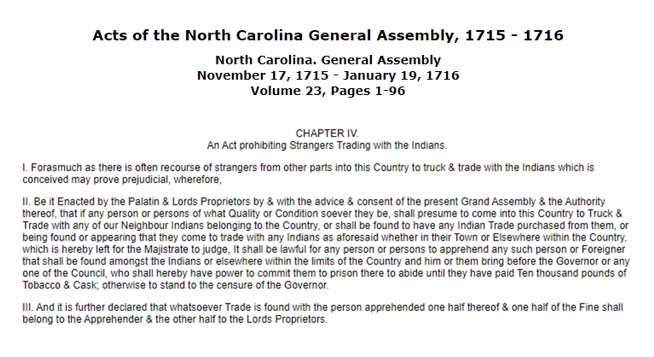
1716
Lt. Governor Alexander Spotswood organized a famous trek over the Blue Ridge mountains that came to be known as the Knights of the Golden Horseshoe expedition.
The Knights of the Golden Horseshoe expedition totaled about fifty people. It was recorded that Spotswood, Fontaine, Beverley, Colonel Robertson, Austin Smith, Todd, Dr. Robinson, Taylor, Mason, Brook, Captains Clouder and Smith, a number of rangers, pioneers, and four Meherrin Indians were in this expedition.
The following is an 19 Century engraving titled “Expedition Of Virginia Governor Alexander Spotswood And The Knights Of The Golden Horseshoe Through The Blue Ridge Mountain In 1716”
The Indians included in this engraving are Meherrin.
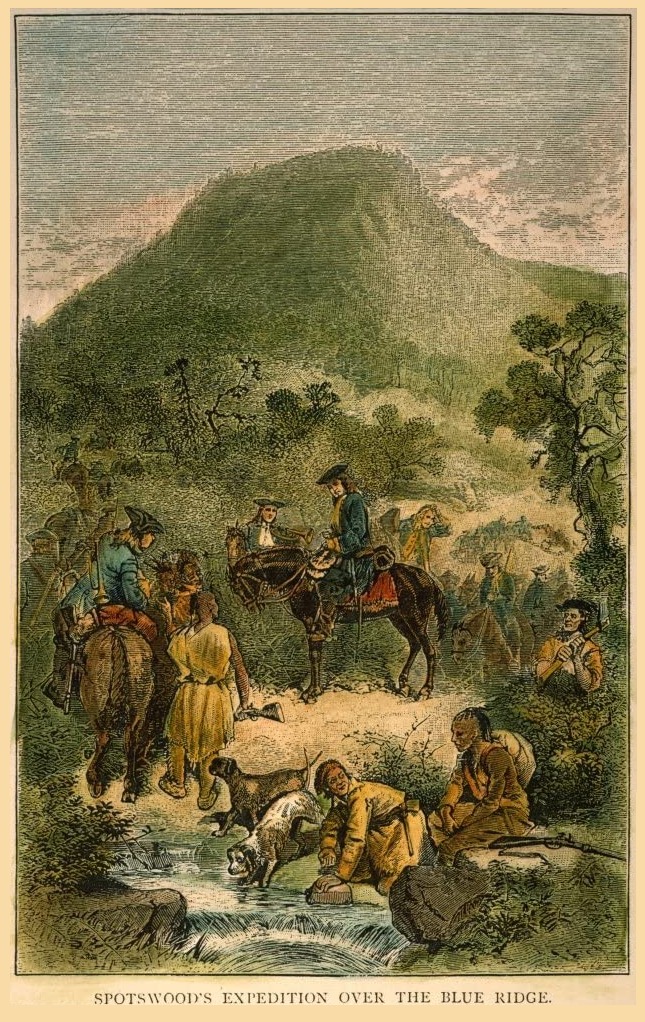

1716
April 26, 1716
At seven we got up, and several gentlemen of the country, that were to meet the Governor at this place for the expedition, arrived here, as also two companies of Rangers, consisting each of six men, and an officer. Four Meherrin Indians also came.
The Indians included in this engraving are Meherrin.
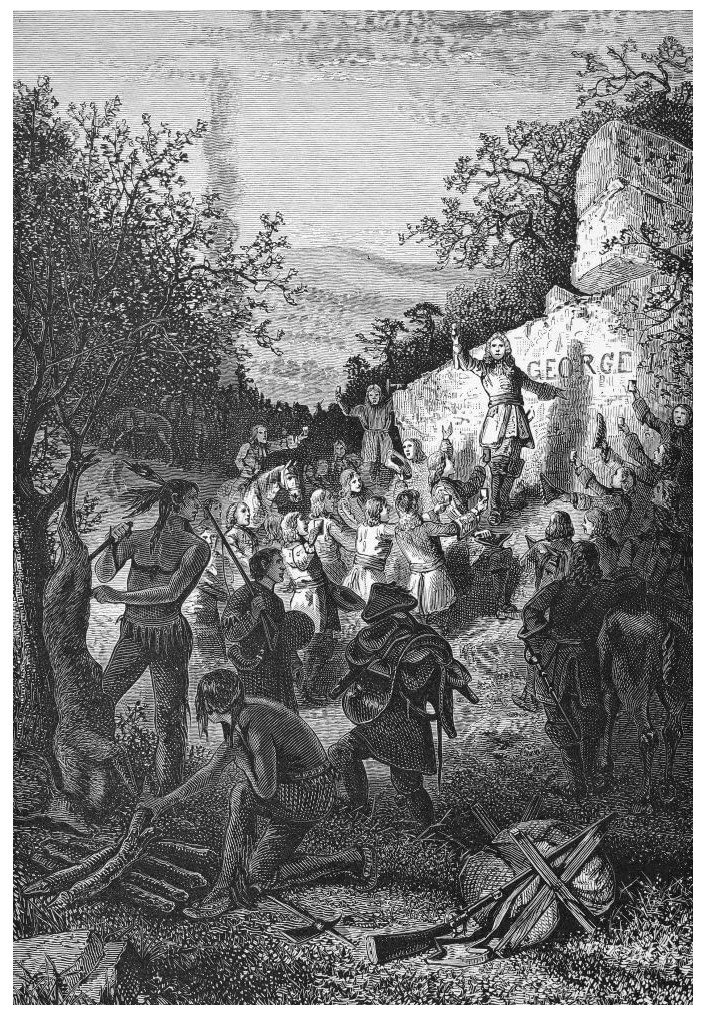
1716
August 31, 1716
Four Meherrin guides were with Governor Alexander Spotswood when he made camp.
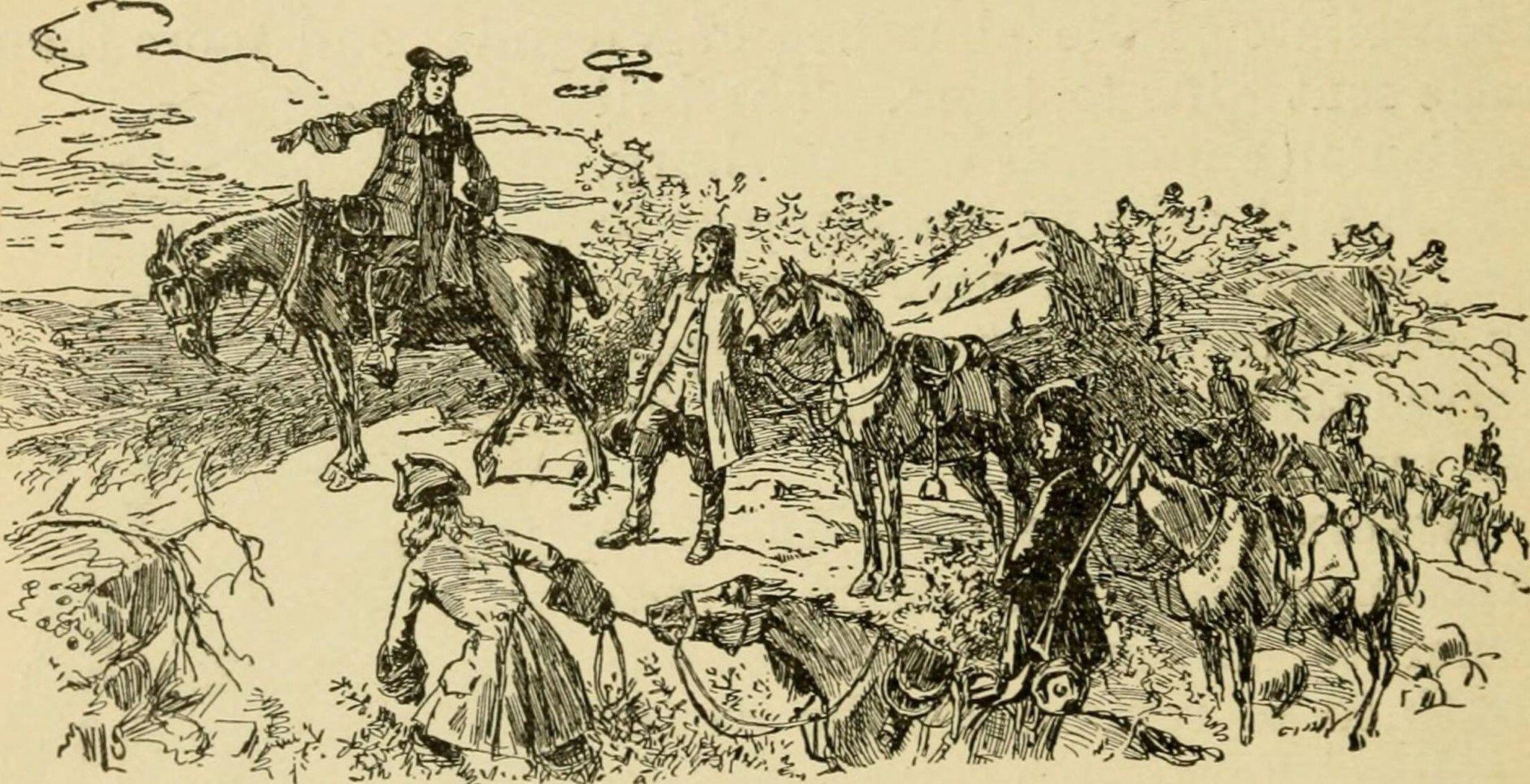
1716
On Sept 5, 1716, guided by four Meherrin Indians, Lieutenant Governor Alexander Spotswood and his party crossed the Blue Ridge Mountains into the Shenandoah Valley. 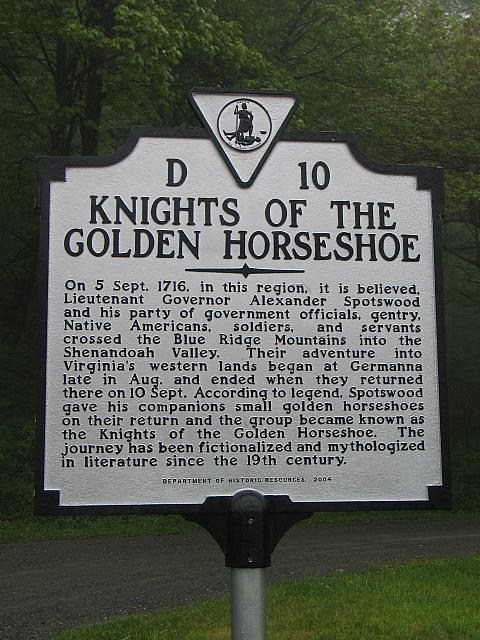
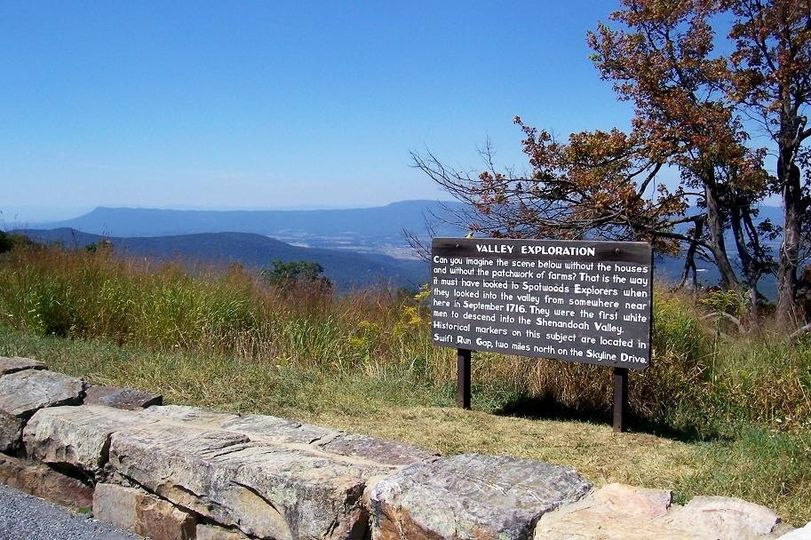
1716
The Indian school at Fort Christanna operated under Charles Griffin. There were 78 Indian children held there. Sons of leaders of Virginia and North Carolina tribes, including Meherrin, were held at Fort Christanna as hostages, to ensure that Native nations would not attack the colonies.
Two of the children of the Meherrin Principal Chief- Ununtequero were taken and held by the Virginia Colony at William and Mary in Williamsburg. The children were held as leverage to prevent the Meherrin from attacking colonists. This also happened at the same time with the Pamunkey queen’s children, as well as children from the Nottoway and Nansemond Nations. At Williamsburg, the children were forcibly kept in poor conditions and suffered from disease and improper care. Many Indian children died under these conditions. It was noted that the Indian children had exceptional abilities and “genius” in drawing. They learned to read and write in English and were Christianized, however the Church would not baptize them because they were not European. Their classroom had a partition to separate the Indian children from the Whites. It was reported that after completing school and freed, most Indian children returned to their own people and their traditional way of life where they enjoyed more “pleasures and plenty as Indians.” In the 1720’s the authorities began sending Indian children to work at sea or as apprentices upon completion of their studies, rather than allow them to return to their own people.
(Rountree, Helen C. Pocahontas’s people: the Powhatan Indians of Virginia through four centuries. University of Oklahoma Press, 1996.)
1718
In 1718, the Nottoway and Meherrin went to the Seneca with a wampum belt, in an
offer of peace. This made the Virginia government anxious about “the danger of suffering the Nottoway and Maherine Indians to bring in the said Northern Indians”
(Mcllwaine, Vol. 111:513- 514, November 3, 1719).
(The Secret History of the Meherrin page 96)
1719
“The Governor desiring the advice of the Council how the incursions of the Indians may be best prevented and the Inhabitants freed from the frequent Alarms occasioned by their Marches through our Frontier Plantations and also representing the danger of suffering the Nottoway and Maherine Indians to bring in the said Northern Indians, and the Tuscoruros to Revenge their Quarrel on the Saponies…. That in order thereto the great Men of the Nottoway Maherine and Saponie Indians be directed to attend this Board on Tuesday the Eighth of December next…”
Virginia Executive Journals of Council (Mcllwaine) III: 513-514. November 3 , 1719
1719
“…And that neither the Tuscoruros nor the Saponies are come in as was expected but there being now here some of the Senequas, Nottoways and Maherine Indians he thought it proper to discourse them after dispatching some other affairs which he had now to lay before this Board.”
Virginia Executive Journals of Council (Mcllwaine) III: 517. Decem ber 9, 1719
1719
“The Nottoway and M aherine Indians were brought before the Governor in Council and Interrogated why they did not prosecute their Complaint against the Saponies and bring down the Witnesses they pretended to have for proving the murder Complained of – Answered that the Great Men of the Saponies told him he would not come to Williamsburgh nay more about that matter and therefore they thought it unnecessary to Attend and being further asked if they had any Witnesses to prove the Saponies guilty of that Murther they said they had no other but the one of their own Nation whom they mentioned when they were last here then they were asked if they did not since a time was appointed for hearing their complaint joyn with the Senequas and Tuscoruros in an Attack on the Saponies at Christanna where they
knew the English at that time Lived, They acknowledged that Eight Nottoways and twelve Maherines (a List of whose names they gave in at the Board) did joyn the Senequas and Tuscoruros and attack the Saponies at the Fort of Christanna in October last…. Ordered That the Northern Indians have Leave to Stay at the Nottoway Town or amongst the English Inhabitants until the tenth of January…”
Virginia Executive Journals of Council (Mcllwaine) III: 517. December 9, 1719
1719
Eight Nottoway* and twelve Maherine* (a List of whose names they gave in at the Board) did joyn the Senequas and Tucomros and attack the Saponies at the Fort of Christanna in October last…
(Mcllwaine, Vol. 111:517, December 9, 1719).
(The Secret History of the Meherrin page 96)
1719
Dec 10, 1719
The Maherine Indians complaining that one John Chesshire hath Seated a Plantation within Two miles of their Town under a Grant from North Carolina and praying to be Redressed therein, the Governor was pleased to say he would write to the Governor of North Carolina and endeavor to obtain their Redress.
Virginia Executive Journals of Council (Mcllwaine) III: 521. December 10, 1719
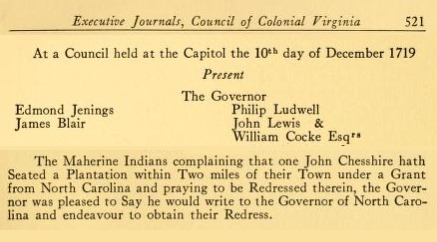
1719
Dec 10, 2019
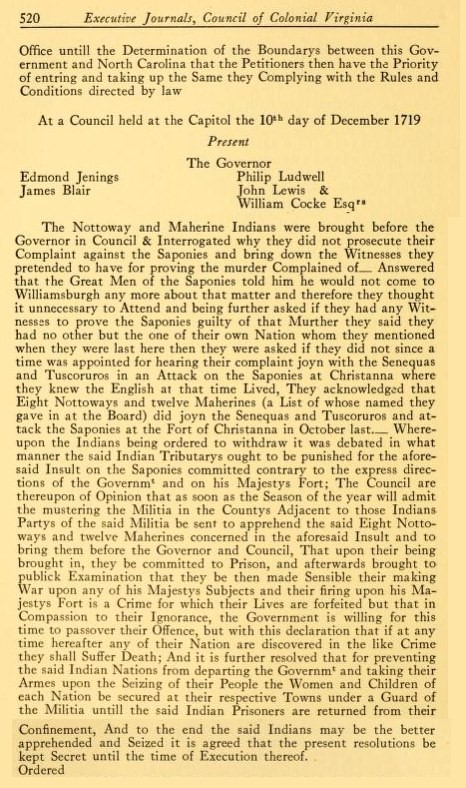
1720
April 22, 1720
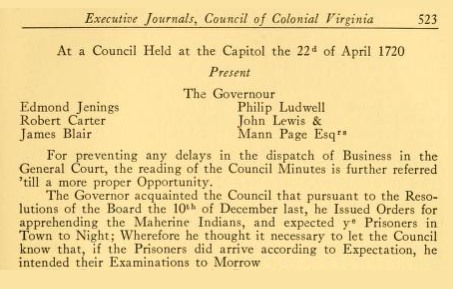
1720
“Pursuant to the Orders of this Board the Chiefmen deputed by the several Indian Nations Tributarys to this Government Viz. the Nottoways, Maherine, Nansemond, Saponies, Totteros, Stukannoes, Oeconeeche’s, attended the Governor and Council, and were told that the Govemour of Pennsylvania having in behalf of the Connestogo, Ganowass and Showanoe Indians living under that Government sent hither to desire a peace with the said Tributary Indians and for that purpose sent two Belts of Wampum in token of their Friendship… the said Deputys in behalf of their respective Nations Declared that they were very desirous on their part to live in Peace with the said Pensilvania Indians and accordingly did agree that from henceforth there shall be a firm Peace between them and the said Indians of the Conestago Ganowass and Showanoe Nations, And that for preventing all occasions of future Discord; they will not at any time herafter… Cross the great Mountains nor pass to the Northward of Potomack River And it is further agreed that at a Confirmation of this Peace, One belt of Wampum shal be made by the Nottoway, Maherine and Nansemond Indians and one other by the Saponie, Tottero Stukanox Occonechee Indians and delivered to the Governor…”
Virginia Executive Journals o f Council (Mcllwaine) III: 533-534. November 12, 1720.
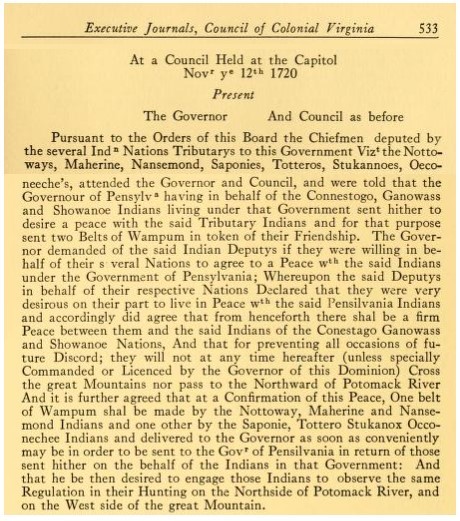
1720
The Meherrin also made a formal peace in 1720 with Pennsylvania’s Conestoga, Ganowass, and Shawnee Indians (Mcllwaine, Vol. 111:533-534; November 12, 1720, Document B-x). In this effort they were associated with the Nottoway and Nansemond tribes, while the Saponi, Tutelo, Stukanox, and Occaneechi formed a separate diplomatic group. These references make it clear that in this period the Nottoway and Meherrin (and perhaps the Nansemond as well) were acting as a single political unit in matters of foreign relations. In fact, their names are more closely associated in the 18th century than they were in the 17th.
(The Secret History of the Meherrin pages 96-97)
1720
Nov 12th, 1720
Peace Treaty with Conestgo, Ganowass, and Showanoe Nations.
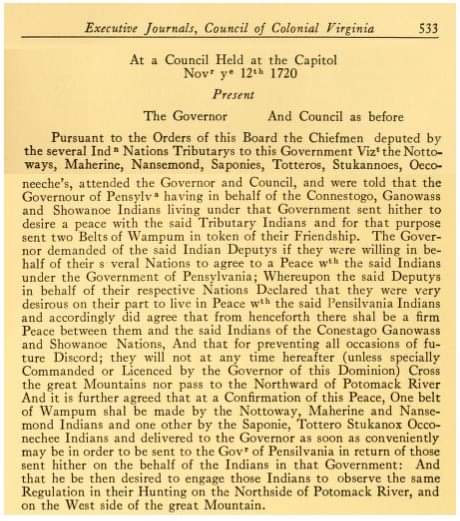
1720
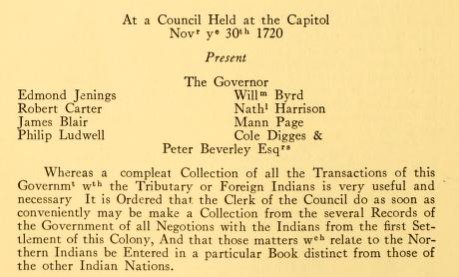
1721 (1)
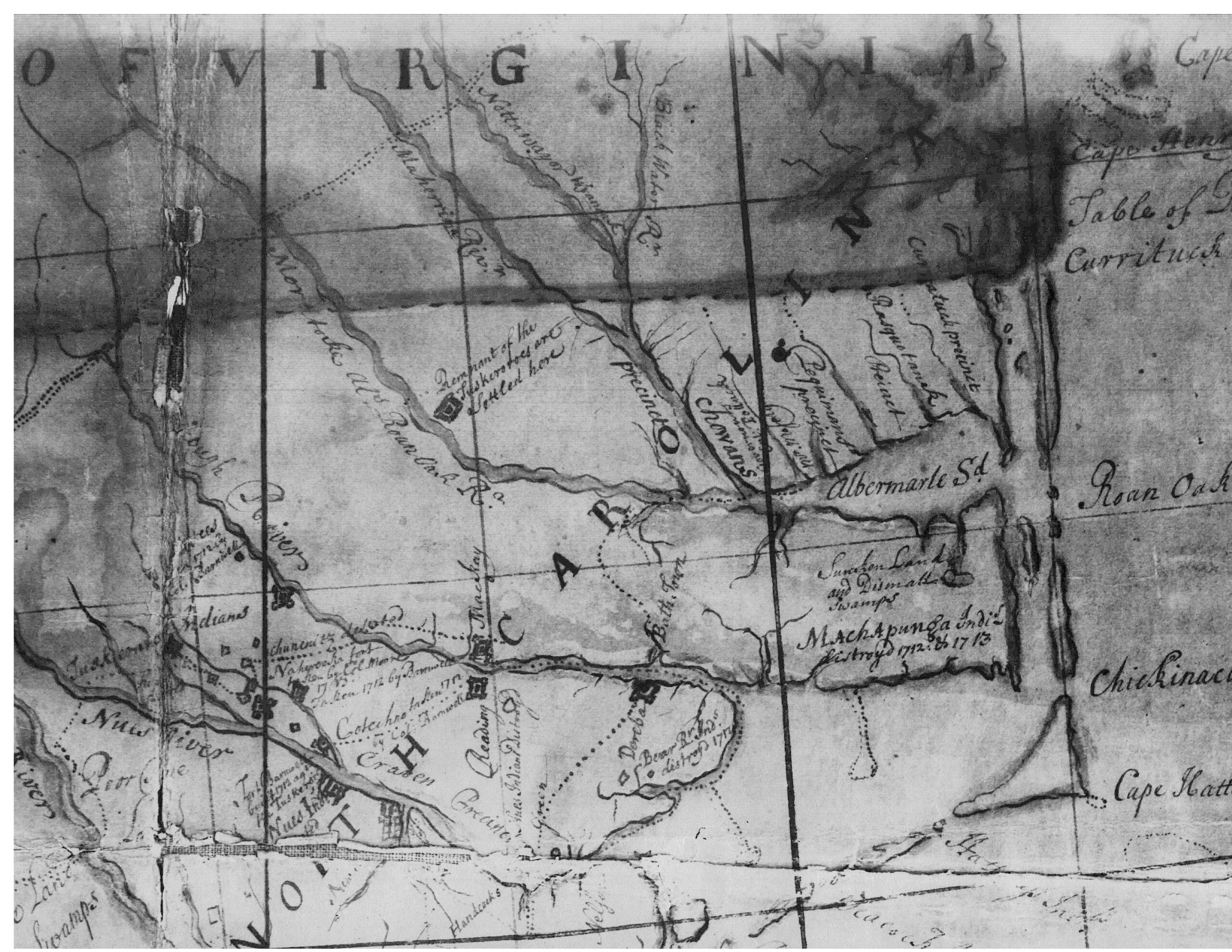

1721 (2)
“.. .it is hereby Ordered, That in Case ye said Willm Flower or any other person shal under such pretended Grant from the Government of North Carolina, or otherwise offer to seat any Plantations, or make any Buildings or improvements upon any of the Lands assigned either to the said Nansemond Indians, or ye Maherines, that then upon Notice thereof given to the Sherifs of the Countys of Nansemond or Isle of Wight or either of them, the said Sherifs and each of them be, and they are hereby Ordered & Required forthwith to pull down and destroy all Houses, Fences, and other improvements so made on or near any of the said Indian Lands. And in Case of resistance to take with them respectively the Posse of their Countys for the better putting this Order in Execution.”
Virginia Executive Journals of Council (Mcllwaine), Vol. IV: 2-3. October 30, 1721.
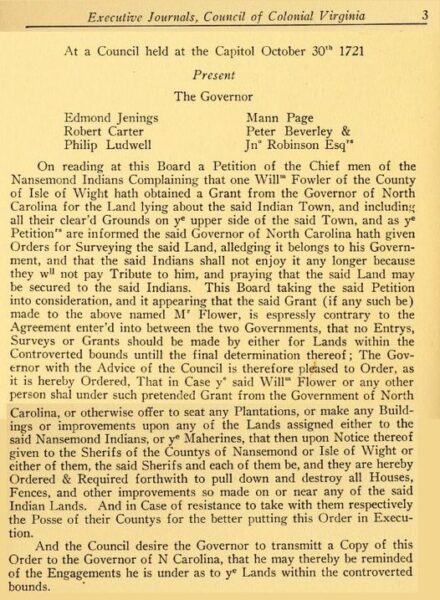
1722
1722 Location of English and Indian Settlements.
An Ethnohistory of the Nottoway, Meherrin and Weanock Indians of Southeastern Virginia – Lewis R. Binford
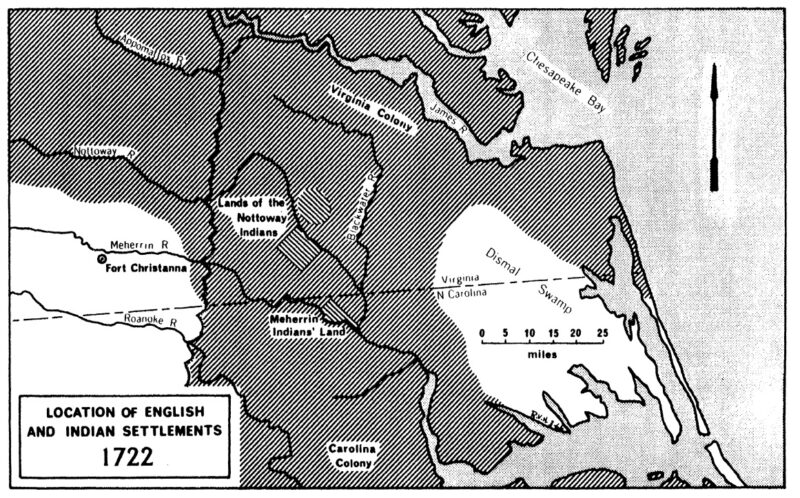
1723
April 26, 1723.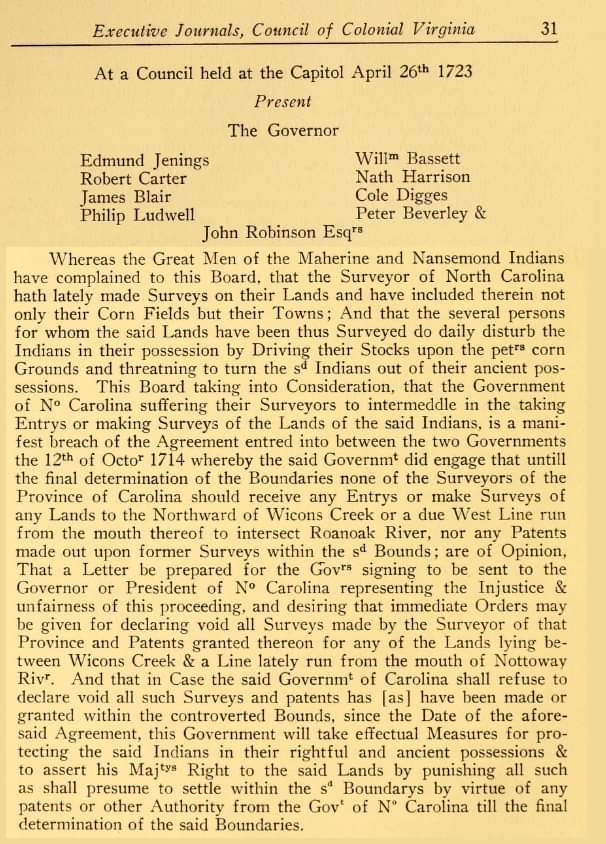
1723
Sept 9, 1723.
Meherrin Indians, Petition to the Governor of Virginia, 1723
This petition was most likely written by Henry Briggs Interpreter to the Meherrin Indians from 1705 until 1726.
Citation: Virginia (Colony), Colonial Papers, Petition of the Meherrin Indians, 1723 Sept. 9. Accession 36138. State government records collection, The Library of Virginia, Richmond, Virginia.

1723
“Whereas the Maherine and Nancemond Indians have this day complained that notwithstanding the repeated Orders of this Government for securing to them the possession of their Lands whereon they have for many Years past been seated between Nottoway and Maherine Rivers divers persons under pretence of Grants from the Government of No.
Carolina have surveyed the Lands of the said Indians, and begun to make Settlements within their cleared Grounds; It is the Opinion of the Council that the Governor be requested to repeat his Instances to the Governor or President of No. Carolina for the time being to recall all such Grants as have been made by that Government within the Bounds in dispute between the two Collonys; and more particularly that the Goverment of No. Carolina take care no persons
pretending to Authority from thence to disturb the Indians in the possession of the Lands they enjoy by Virtue of Treaties of the Peace which have been approved and confirmed by the Crown. And because the President of No. Carolina has hitherto thought fitt to take no Notice of a Letter sent him last April upon a former Complaint of the Nancemond and Maherine Indians, It is Ordered that a Copy of the Order of this Board dated the 30th of October 1721
be now sent to the Governor or president of No. Carolina for the time being with Intimation that in Case that Government do not immediately put a stop to the Incroachments complained of by the said Indians; and also recall all Grants and to annull all Surveys made within the contoverted Bounds since the mutuall Agreement entred into by both Governments in the Year 1714 Orders will be forthwith given pursuant to the Resolutions of the Board the 30th of
October 1721 for removing by force all persons seated within the said controverted Bounds under pretence of any Grant or Authority from the said Government of No. Carolina.”
Virginia Executive Journals of Council (Mcllwaine) IV: 53-54. October 24, 1723
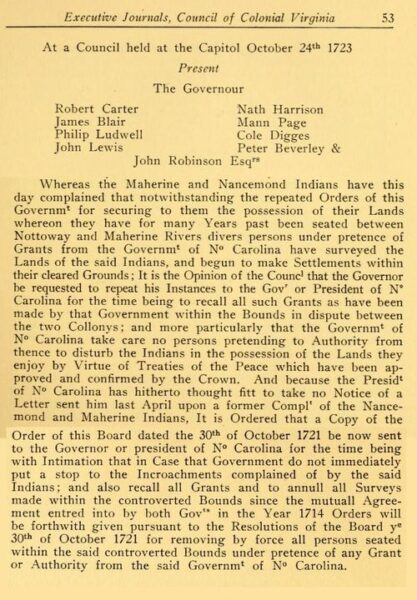
1723
Dec 11, 1723
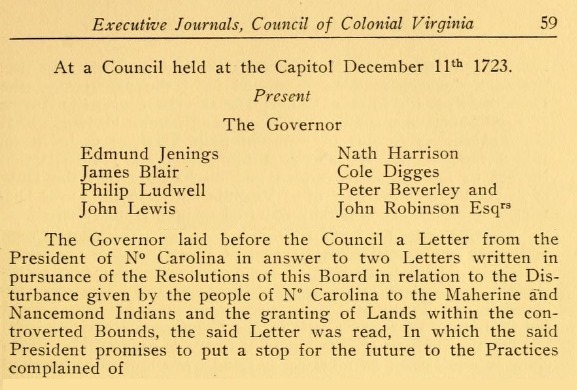
1724
“Upon complaint of the Maherine Indians, setting forth that their lands were all taken up and surveyed by the English their neighbors, and that they were forewarned off from their clear grounds and forbid to plant corn thereon…”
Colonial Records of North Carolina II: 526-517. April 9, 1724.
